Sending and Targeting Surveys to Anyone With the Distribution Link
Sending and Targeting Surveys to Anyone With the New Distribution Link
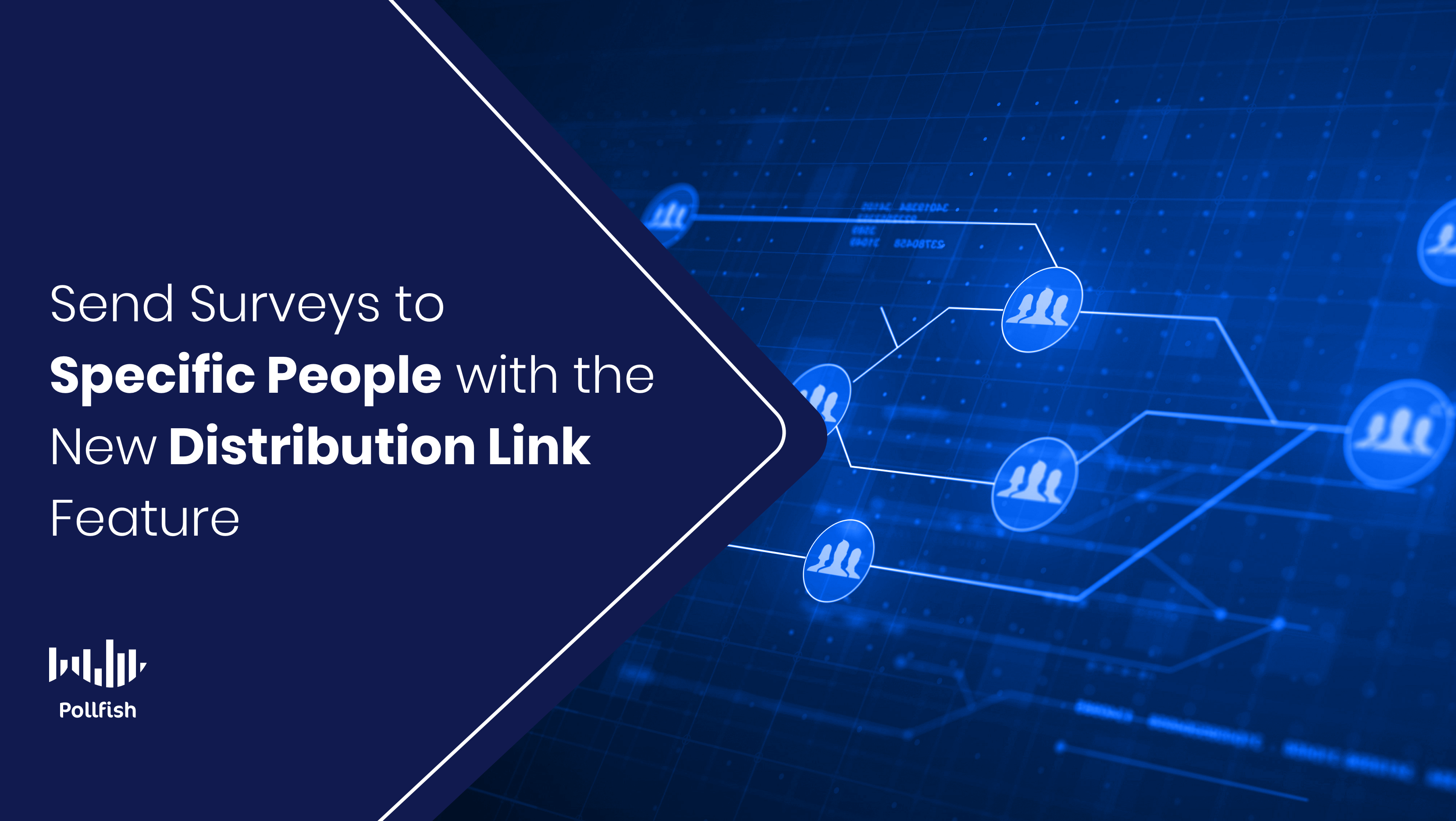
The Pollfish platform just got much more powerful. We now offer another major way to deploy surveys so that researchers can target the exact people they seek to study for all of their research needs.
We’re thrilled to introduce the Distribution Link, a feature that completes the Pollfish survey distribution and deployment functionality. It is currently FREE to use this DIY market research tool.
With this latest feature, you can target respondents in the most precise way: via their identities instead of their demographics, location, and other screening filters you’ll find on our platform.
This feature fortifies your survey outreach process, arming you with the knowledge of specific respondents. As such, it provides a powerful addition to market research techniques and gives you the full Pollfish experience.
This article explains the Pollfish Distribution Link feature, so that you can apply it to all your unique respondent targeting needs.
Understanding the Pollfish Distribution Link Product Feature
The Distribution Link is a new product feature for distributing your surveys to the exact targets you seek to complete them. It serves as an alternative to our current survey deployment method: that of random device engagement sampling or RDE sampling.
With RDE sampling, the Pollfish platform launches your survey to hundreds of thousands of highly-trafficked websites, mobile sites and apps, prompting random internet users to take your surveys. Of course, only those who qualify to take it based on your screening section are granted entry into the survey.
This way, only members of your targeted population will participate in your survey and they are targeted in a completely randomized way. While this strategy is useful and efficient, bringing you quality data and speed to insights, it was rather incomplete.
This is not to say that you couldn’t extract high-quality data from the Pollfish platform through its survey fraud protection and quality checks system or that you couldn’t target people based on demographics, psychographics, location, etc via the RDE approach. In fact, that is exactly what the RDE method was built for: quick insights from a vast and random sampling pool.
While this is an innovative approach, it was incomplete in that it didn’t allow you to send your survey(s) yourself to specific individuals. But now you can with the Distribution Link feature.
The Distribution Link allows researchers to send their survey(s) themselves to their exact targets, actual individuals rather than a random pool. But it can do much more.
Since this feature is a link, you can send it through various means and reap various benefits.
Distribution Link Facts, Cost and How to Add it to Your Survey Campaign
The researcher can create a draft and instead of distributing it via the Pollfish network, they can generate a link that potential respondents can click on to reach the survey. As such, there will be no checkout page, but a link that researchers can share across mediums.
The first release is available for all accounts for free.
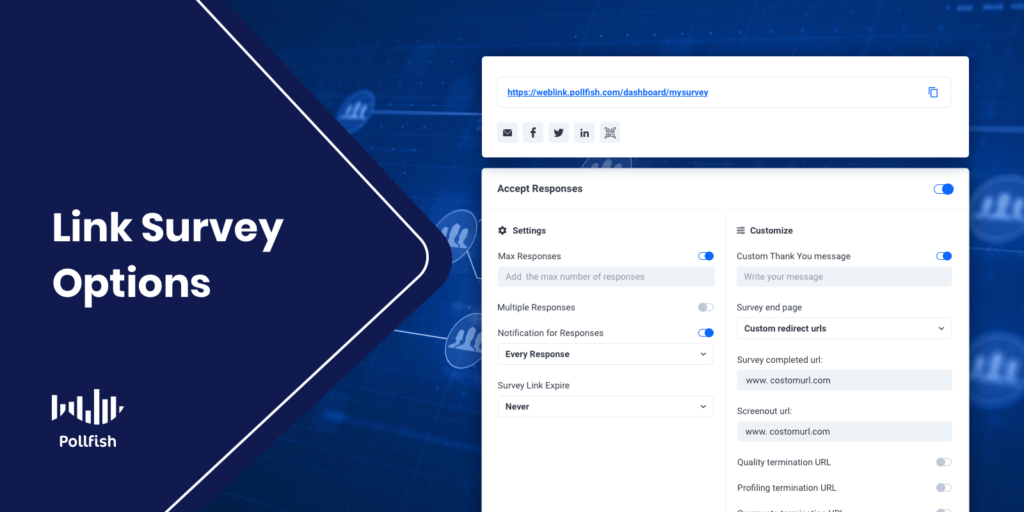
The following explains how to apply the Distribution Link feature to your survey:
- Click on ‘’Create new survey’’ on the Pollfish platform.
- Then, select the option of “create a link” to share the survey.
- Select to start through a template or from scratch.
- You’ll then be directed to the Questionnaire page, where you can select your intended respondent demographics and other qualifications.
- You can also add screening questions that will allow or bar entry to the survey to respondents who answer them in a particular way.
- After filtering options in the Questionnaire page, Then you’ll be taken to the Questionnaire page, where you can design your questionnaire or alter the template.
- If you want to screen your audience do so through the ADL tab.
- When you send a user to the end of a survey through the ADL tab, this is due to:
- A successful survey completion
- Screen out termination
- Profiling termination
- Quality termination
Please note the following changes we’ve made in 2022:
Quality termination is replacing the Disqualification rules feature in the Distribution Link feature. Additionally, screenout and profiling terminations through ADL are replacing the Audience page and screening questions in this feature.
Capabilities and Benefits of the Distribution Link Feature
This feature presents a potent way to collect survey responses; as such, it is another means of survey sampling methods. It has a slew of various capabilities and benefits. The following lists all that researchers can do with the Distribution Link feature:
- Appears as an easy-to-access, sharable link.
- Allows you to hyper-target your target market sample.
- Permits you to reach specific individuals.
- Grants you the power to survey consumers and leads at key moments in their customer journey.
- Enables you to gain consumer opinions about events in their customer experience (CX) while they’re fresh on their minds.
- Allows you to understand what customers don’t like or where you went wrong as these events are still occurring.
- Gives you access into the minds of specific people, at specific times in their CX.
- Makes it possible to ask consumers about your company, specifically, their experience with it, as opposed to more general questions about their thoughts about your niche and cultural climate.
- Brings you insights from key stakeholders and players in your industry and certain companies.
- Provides an alternative survey sampling approach you can use alongside RDE sampling, allowing you to conduct comparative analyses between the two sets of data.
Methods and Campaigns to Use with the Distribution Link Feature
The Distribution Link feature opens doors to conducting several key market research campaigns. It also augments your survey deployment by providing more methods of sending your surveys. This means you are not limited to sending the surveys to specific people through a single channel.
Instead, this feature offers far more options to carry out your research campaigns and reap critical data for decision making. As such, it diversifies your options for distributing your surveys, along with enabling you to carry out and refine critical business campaigns.

The following lists the different methods and campaigns you can use with the Distribution Link feature:
- Email Specific Targets
- This serves as the classic method for inviting targeted people to take your survey.
- You ought to email consumers at specific times in their customer buying journey.
- There are various points in the customer journey and sales funnel that are opportune to survey your target market, such as: post-purchase, cart abandonment/ lack of purchase, bounces, email list sign-ups, a discussion with a representative, etc.
- There are several best practices you should use to increase your survey completion rate if you choose to email your targets.
- Social Media survey invitations.
- With the Distribution Link feature, you can copy/paste the link to the survey you want to deploy across any social media channel.
- This way, you can compare visitors from social media with other means of extracting data, whether it is with other Distribution LInk methods or via RDE sampling.
- B2B Feedback via B2B surveys
- You can gain critical insights with your business clients, vendors and partners to smooth various contracts, processes, integrations and other business dealings.
- With this feature, you can contact these entities directly, so you’ll know exactly who has provided answers to your survey.
- Create this survey type with the correct B2B survey questions.
- Content Marketing Strategy campaigns
- With RDE sampling, you cannot reach out to specific site users that visited and interacted with your website and its content.
- With the Distribution Link feature, you can survey people who have interacted with your content, are subscribed to your newsletter, visit your site regularly, have signed up for a mailing list, etc.
- The link allows you to attach your brand and its experience to the survey, which is also useful for brand visibility.
- Demand Generation campaigns
- If you do not want to directly mention your survey in social media or email messages/campaigns, you can still use the Distribution Link in your landing pages.
- This provides a more indirect way to access your survey, however, a landing page can provide an in-depth explanation, or a bulleted list describing your survey.
- Use CTAs in your landing pages to link to your Distribution Link survey.
- Employee Feedback Survey Campaigns
- Send surveys to your team only, or even specific departments with various employee-facing surveys.
- Use the employee satisfaction survey or the eNPS survey to gauge employee fulfillment, happiness and how likely they are to recommend working at your organization.
- Keep burnout at bay with the employee burnout survey.
- Recognize high-performing and hard-working employees with the employee recognition survey.
How to Use the Feature
- Create your questionnaire
- Select if you want to ask a question and screen the respondents (for profiling, quality, or screener) through the ADL.
- The Link Settings page is combined with the Share page title :
- Set up maximum responses if need be.
- Allow multiple responses from the same respondent.
- Select if you want to be informed of new responses.
- Set an expiration date for your survey.
- Add a custom “thank you” message.
- Select what will occur when a respondent adds a complete
- Send them to the Pollfish homepage.
- Send them to the results.
- Add custom redirect links.
- The results will be the same as regular ones, with the ability to delete a response.
Passthrough Parameters
This is a new implementation for 2022. In conjunction with the redirect URLs, we now support passthrough parameters. This feature allows researchers to pass different identifiers and parameters through the distribution entry link and redirect URL’s for each respondent or a batch of respondents. All parameters are also saved and are available at the XLS export.
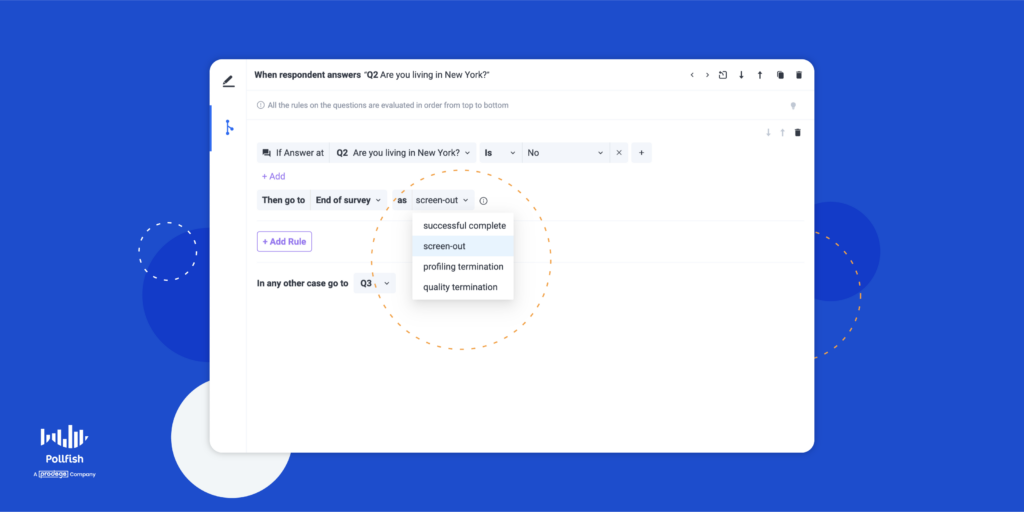
Passthrough parameters allow you to pass information to and from a website by simply adding, or appending, specific information to the end of a URL.
You can append as many parameters as you want to your survey link.So what is their purpose in the context of market research? They enable researchers to pass different identifiers, AKA, parameters through survey URLs. The respondents then retrieve them through the redirect URLs.
They are predominantly used to track and match a respondent with a certain response. In Pollfish, you append the user ID at the entry URL and retrieve it at the redirect URL.
By doing so, you can match a respondent profile from the Pollfish respondent pool with a response on a Distribution Link survey.
Personalizing Your Survey Campaigns
Personalization is crucial in marketing and market research and with the Distribution Link feature, you have the option of personalizing your survey to its targeted respondents. You may know exactly who you seek to target if you’re setting up a B2B survey with a client, vendor or partner.
Or, if a customer on your website provides their key identifying details, such as their name, location, email address and more, this also gives you an avenue for personalization. You can then set up a personalized survey and send it to specific individuals with the Distribution Link.The key is to use a strong online survey platform like Pollfish, which now arms you with this link feature that makes it easy to make your own survey in only three steps. With the Distribution Link feature, Pollfish empowers your market research and general research campaigns more than ever before.
Diving Into the Competitor Survey for All Competitive Analyses
Diving Into the Competitor Survey for All Competitive Analyses
All businesses should deploy the competitor survey periodically, to keep a watchful eye on their competitors and their target market’s perception of their competitors. Competition is alive and well across every vertical, so it is critical to stay in the know on this front.
94% of businesses are investing in competitor intelligence and for good reason, as one of the main reasons why businesses lose their customers is because customers abandon them for their competitors.
In fact, 89% of customers switched to doing business with a company’s rival due to poor customer service. As such, all businesses must strive to surpass their competitors in a variety of matters, from product satisfaction to customer convenience.
That way, they can build brand trust to arm themselves against customers abandoning ship.
This article examines the competitor survey, competitive analysis, its importance, when to use the survey and how to create one.
Understanding the Competitor Survey
The competitor analysis survey is a critical online survey that helps businesses across industries understand their competitors’ business performance, especially in comparison to themselves.
This survey is the leading tool in competitor analysis, which is the practice of identifying your competitors and evaluating them on their strategies, target market perception, strengths and weaknesses and other key characteristics relative to your own.
Competitor analysis allows you to assess and fully understand your market in terms of its key players. It also grants you insight into your own standing and how you compare with your direct contenders.
Competitor analysis helps you assure that you’re allotting resources in productive ways by understanding your competitors, what has worked efficiently for them and what hasn’t. It assures you don’t fall behind and keep up with them, whether it is through product improvement and innovation, customer support, CX and all else.
The competitor survey helps you understand your competitors through the perceptions of your target market. After all, it is your customers whose opinions matter most and you’d be hard-pressed for an employee in your rival company to reveal trade secrets — or any at all.
However, you can still gain competitive insights by surveying certain competitors with B2B surveys. This is especially useful in business partnerships. While you may not get access to your direct competitors, you can still collect crucial information from indirect competitors that help inform on the state of your industry and niche.
Given that competitive analysis is most productive when consistently conducted, you should deploy the competitor survey regularly.
The Importance of the Competitor Survey
This type of survey has several advantages.
First off, by using this survey, you get access to firsthand insights from your customers, allowing you to glean all of their opinions on your competitors’ performance. Whether it comes to their brand messages, products or CX, this survey gives you a clear view into how they see your business rivals.
As such, you can use this survey to form a comparison between you and the competition. You can do so by asking your respondents to choose their favorite brand in a list and include your brand. You can also ask them to rate each brand by using a ranking question.

Additionally, this survey grants you key data into your customer behavior as it relates to your contenders. In this regard, you can survey customers on where they buy from your competitors,’ how they shop from them, how often, whether they’ll buy more during a certain event (ex: promotion) and more. In this way, you can create a kind of RFM analysis from this kind of survey.
It allows you to conduct competitive research by keeping track of your competitors through the eyes of your customers. Essentially, it is a kind of brand tracking, but instead of focusing on how your own brand is perceived, the spotlight is on your counterparts — unless of course, you explicitly ask questions that compare you to your rivals.
By understanding what your target market likes and dislikes about how your competitors operate, you get a twofold advantage. Firstly, you’ll generate ideas on how to run marketing campaigns, how to innovate your products, augment your customer support and improve across your entire customer experience. Secondly, you’ll also know what to avoid and do away with, based on what your customers view unfavorably about your opponents.
In regards to the former, you’ll also form ideas on how to target and acquire new customers, which has the potential to lower your customer acquisition cost. This is because you’ll be armed with data for decision-making, the kind that shows you exactly what your target customers want and expect.
When to Use a Competitor Survey
There are various times to implement the competitor survey for your competitive analysis. These often depend on your marketing campaigns and the time of the year. The following includes several opportune times for deploying this kind of survey.
- Shortly after your competitor(s) release new products or services.
- During heightened times of customer attrition. For example, when you notice high bounce rates on product and landing pages, along with customers abandoning their shopping carts.
- Shortly after you released new products, a new campaign or content.
- This can include new services.
- This can also include new website experiences, whether you offer a new subscription, UI elements, etc.
- During an in-home use test.
- One of many market research techniques, this allows companies to understand how their target market interacts with their products before they officially launch them.
- It grants businesses to understand how their customers use their products in natural settings instead of at customer facilities.
- Before launching a new product or innovating on a product idea.
- You should be aware of similar such products from your competitors along with your customers’ opinions of them.
- This way, when forming new products as well as post-production but before they go to market, you will understand how to best market them.
How to Create a Competitor Survey
To create a competitor survey, you will first need to work on another aspect of competitor analysis: identifying your competitors. This requires doing some secondary market research. A good starting point is to google the products sold within your niche.
Pay attention to the first and second-page rankings of the SERP (search engine results page). Additionally, take a look at the ads that show; these will appear at the very top of the SERP and are marked by the word “ads.”
When you google the common offering found in your niche, you’ll notice some competitors will rank for content aside from only the products and services. Some of these will take the form of a featured snippet. This kind of positioning places content above the very first search engine result.
Instead of appearing as a link and meta description, the snippet extracts more information from the page it’s highlighting. As such, the extracted content will be longer.
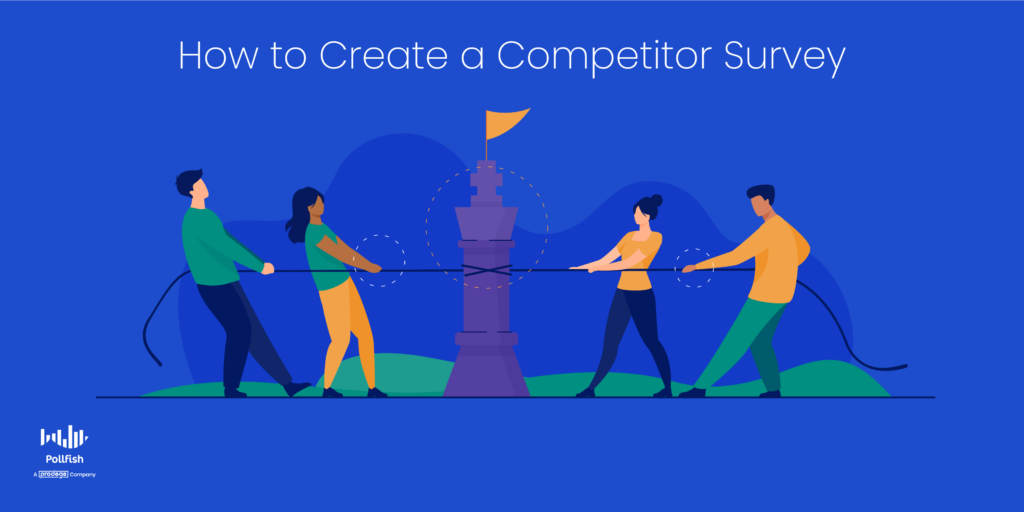 Companies that land feature snippets perform well in terms of SEO. As you’re gathering your list of competitors, you can move on to the following steps, which guide you on how to create the competitor survey:
Companies that land feature snippets perform well in terms of SEO. As you’re gathering your list of competitors, you can move on to the following steps, which guide you on how to create the competitor survey:
- Put together a list of at least 10 competitors, including indirect competitors.
- Start by understanding how customers feel about them by targeting your various market segments and customer personas in a preliminary competitor survey.
- In this survey, conduct brand awareness research on your competitors to see whether your customers know about their existence before you probe any further.
- This will keep your survey short, which is a general survey best practice.
- Next, choose a particular theme and campaign for the survey study.
- It can be based on a new product your competitor released, a seasonal campaign, or one with general questions about how customers feel about it.
- Use the above section on when to use this survey to provide some ideas on when to launch its study and what to base the study on.
- Create several key questions based on the theme of the study.
- Deploy your survey at a favorable time.
- Learn about the best time to send a survey.
- You should send it to a vast publishing network, along with identified, individual customers.
- Analyze your survey results.
- Decide whether you need further information and if you do, create a follow-up survey.
- Choose another theme for the survey.
- There are plenty of topics to base your survey on, such as testing the brand trust of your contenders or for brand tracking.
- Analyze and iterate if need be.
- Then, make decisions based on your customer data.
Staying Ahead of the Competition
To remain competitive, you’ll need to conduct a competitive analysis of your competition. You can easily achieve this with survey research. The key is to find a stong online survey platform to carry out your research and present it in a way that’s most convenient for you.
As such, you should use an online survey platform that makes it easy to create and deploy consumer surveys. It should offer random device engagement (RDE) sampling to reach customers in their natural digital environments, as opposed to pre-recruiting them.
You should also use a mobile-first platform since mobile dominates the digital space and no one wants to take surveys in a mobile environment that’s not adept for mobile devices.
Your online survey platform should also offer artificial intelligence and machine learning to remove low-quality data, disqualify low-quality data and offer a broad range of survey and question types.
The survey platform should offer advanced skip logic to route respondents to relevant follow-up questions based on their previous answers. It should also make it easy to form a customer journey survey to survey your respondents across their customer journeys.
Additionally, it should also allow you to survey anyone. As such, you’ll need a platform with a reach to millions of consumers, along with one that offers the Distribution Link feature. This feature will allow you to send your survey to specific customers, instead of only deploying them across a vast network.
With an online survey platform with all of these capabilities, you’ll be able to gain useful insights on your competitors from your target market.
How to Avoid Order Cancellation with Market Research
How to Avoid Order Cancellation with Market Research
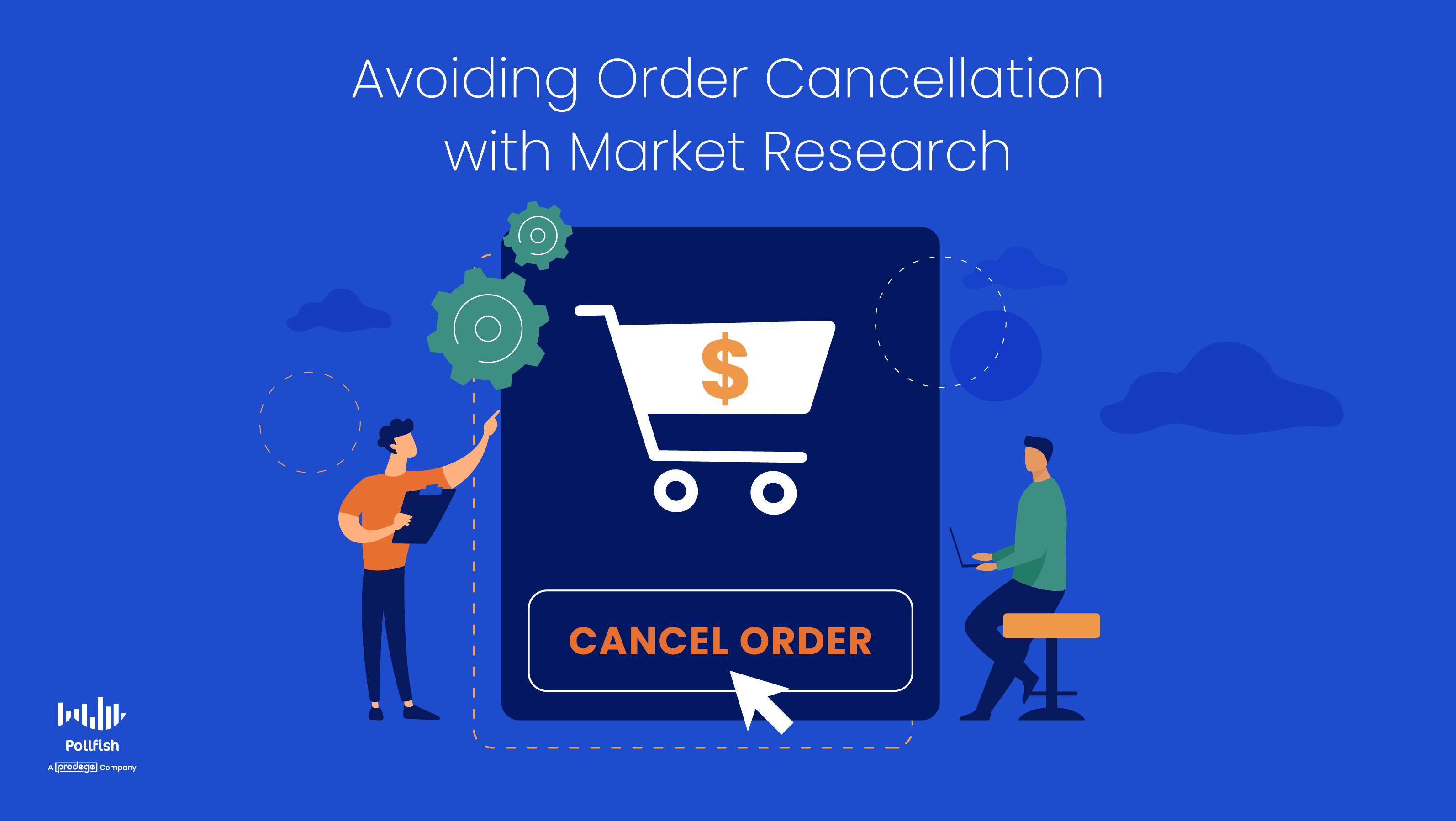
All businesses contend with the negative outcome of order cancellation, some at far higher rates than others.
Aside from canceling orders, some orders that go through wind up being canceled post-purchase, as 30% of all products ordered online are returned, compared to 8.89% in brick-and-mortar stores.
Although it is expected for customers to return products, incurring this rate of cancellation is worrisome, as it represents almost a third of lost revenue.
Unfortunately, order cancellation doesn’t merely occur within products, as it also rears its head in subscriptions. Nearly 40% of subscribers of any service type cancel in less than three months; over half of all subscribers cancel within six.
You can find the root cause of order cancellation, which almost always includes some customer dissatisfaction by conducting market research.
This article lays out order cancellation in its various contexts, its causes, how to reduce it through best practices and market research.
Understanding the Contexts of Order Cancellation
As the introduction briefly touched upon, order cancellation doesn’t simply occur among product purchases. Instead, order cancellation refers to the abandonment of all products and services that your target market was in the process of buying, along with the reversal of already purchased products and services.
In the case of the latter scenario, customers cancel an order they’ve already purchased or received, or in some cases, have already used for a certain amount of time, which often is determined by a business’ return window.
Customers cancel their orders for many reasons. The root source of order cancellation is customer dissatisfaction, as the number one reason customers cancel an order is due to changing their minds. Customers can change their minds for several reasons and due to various situations.
The key is to discover the causes of unhappiness among customers when interacting with your business, whether it stems from the products/services themselves, communication issues with your customer service team, or a lack of catering to other consumer preferences.
To avoid order cancellation, you ought to fully understand the contexts and causes of it.
The Causes of Order Cancellation
As aforementioned, order cancellation often occurs when customers experience dissatisfaction and unhappiness. These sentiments do not merely occur after customers have used a product or service, as various factors affect customer satisfaction and customer expectations.
The following addresses common causes behind canceled orders, whether they are products, subscriptions, or other services:
- Longer Deliveries
- 38% of online shoppers will cancel their order if the delivery will take longer than a week.
- This rate declines when fewer days are required to wait for the delivery.
- For example, 16% of customers will drop their order if the delivery takes 6-7 days; 15% will cancel their order if the delivery takes 4-5 days and 8% will abandon their order if delivery arrives in 3 days or fewer.
- No mention of a delivery date
- 24% of shoppers would cancel their order if the business they’re patronizing provides no delivery date.
- Customers don’t appreciate being kept in the dark about when they’ll receive their purchases.
- Unexpected Shipping costs
- 25% of online shoppers will cancel their order due to unexpected shipping costs added to the order just before the checkout.
- In this respect, transparency is key, especially since it involves prices.
- High Shipping costs
- 63% of shoppers abandon their orders due to excessive shipping costs.
- When customers abandon their carts, they often turn to competitors who offer the same or similar products or services, but at lower or no-cost shipping.
- Over-purchasing
- 30% of shoppers deliberately over-purchase and subsequently return unwanted items.
- 19% of shoppers order multiple versions of the same item, which they use to decide once they’re delivered.
- Certain customer personas are prone to purchase more due to income, lifestyle or simply to later compare products.
- Loss of interest or need
- This can occur among products or subscriptions, whether they are of the physical or digital kind.
- An example of the former includes subscriptions to items, such as hobby items (arts and crafts, toiletries, etc.) and food deliveries.
- An example of the latter can include SaaS subscriptions or content websites, such as news sites, trade publications, statistics sites and market research publications.
How to Avoid Order Cancellation with Market Research
Despite the many sources of order cancellation, you can reduce it by conducting market research. This kind of consumer research allows businesses to understand their target market in greater depth.
By understanding all your customers’ wants, needs, interests, aversions and customer behavior, you’ll be in sync with your customers, allowing you to properly meet all of their needs. After all, the most ideal way to innovate, market and communicate with your customers is by knowing what they want and expect in the first place.
There are various market research techniques that you can apply to understand your customers in greater detail. This involves researching their preferences surrounding checkout, shipping and all other topics that involve their placement of an order, whether it is digital or physical.
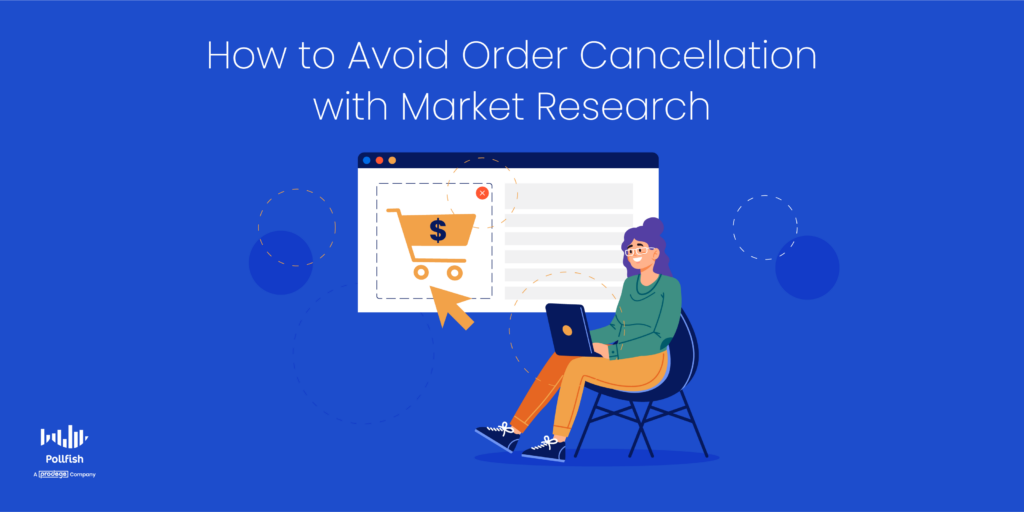 Given that many cancellations occur before a customer receives or uses their purchases, many of these topics involve your customers’ UX, as they include the usability of placing an order and navigating your website and other digital properties. As such, you can conduct research on this aspect with the UX survey by using the proper UX survey questions.
Given that many cancellations occur before a customer receives or uses their purchases, many of these topics involve your customers’ UX, as they include the usability of placing an order and navigating your website and other digital properties. As such, you can conduct research on this aspect with the UX survey by using the proper UX survey questions.
To better understand how easy or difficult it is for your customers to interact with your company at any touchpoint, you should use the CES survey, aka the Customer Effort Score survey. This survey involves using its titular score, which measures the degree or amount of effort that a customer puts into a certain interaction with a business.
To reduce order cancellation, use it to study your customers’ at any touchpoint that involves an order, whether it leads up to it, or occurs post-purchase. As such, you can ask questions that inquire into ordering something online, over the phone, changing an order, dealing with customer service and more.
Given that most order cancellations — especially those that involve customers changing their minds — involve customer satisfaction, particularly a lack thereof, you should conduct the customer satisfaction survey and its varieties.
This survey allows you to dig deep into various aspects of the customer experience in which customers can rate their satisfaction, as well as sound off on what went amiss, what they liked and didn’t like, along with the possibility of providing a recommendation. As for the latter, the best bet is to send an NPS survey (Net Promoter Score Survey), which uses a scale of 1-10, in which customers rate the likeness of their recommending the company to others.
There are various other kinds of surveys you can use to reduce order cancellation, such as the customer experience survey, which addresses various aspects of the CX. You can use it to zoom in on purchases, orders and customer buying behavior.
When to Apply Surveys to Reduce Order Cancellation
Don’t forget to survey various customers at various points in their customer buying journey to retain them. When you retain customers, you’ll in turn build loyalty and stamp out customer attrition, therefore lowering the chances of order cancellation.
The following lists when to survey customers and which points in the customer journey you should pay particular attention to minimize cancellations:
- Customers who have saved items in their cart or wish list.
- Customers who have abandoned their cart.
- Customers who subscribed to a newsletter or other email messaging service.
- Those who have interacted with your UI or other digital properties.
- Those who have interacted with customer service, whether in-store, over email, phone, or chat.
- Those who made a recent purchase.
- Those who went back to change anything in their order, whether it is its quantity, a new item, change of address, delivery method, etc.
- Customers who are waiting on a purchase delivery.
- Customers who have canceled orders before they’ve arrived or have used them (includes both physical and digital subscriptions).
- Customers who have received and used their purchases for some time (ranging from a week to months, depending on their purchase).
Best Practices to Use in the CX to Stamp Out Order Cancellation
Aside from carrying out market research, you should follow several best practices to minimize order cancellations. These will allow you to build loyalty by retaining your customers and therefore, the order that they make.
The following list displays the best practices to use to curb order cancellation. It addresses the causes of canceled orders that were highlighted in the previous section. Once you use these practices hand-in-hand with market research, you’ll be on the right track to fostering retention.
- Avoid long delivery times.
- Offer quicker delivery options, such as two-day shipping, next-day and even same-day delivery if possible.
- This will give customers various delivery choices which they can choose based on their spending power and the urgency of their purchase.
- Today’s customers have grown accustomed to rapid delivery options in e-commerce.
- If a business cannot meet that demand, customers will turn elsewhere to buy from a business that can.
- Always include delivery dates.
- Never leave customers wondering when they’ll receive their items or subscriptions.
- Creating uncertainty will only taint their perception and trust in your business.
- If you’re not sure because if the delivery service you use isn’t certain either, offer an estimated delivery time.

- Be upfront with all shipping and delivery costs.
- Aside from hiding the date of delivery, omitting shipping and delivery costs is a major mistake.
- Customers want to be in the know of how much they’ll be charged.
- Whether you offer a few, a single, or various delivery options, always include all the fees involved.
- Keep shipping and handling costs low.
- Consider the fact that most customers are investing in your products and services. As such, they will want to keep shipping fees to a minimum.
- Additionally, customers have become accustomed to free or discounted shipping fees that many companies offer.
- Offer as many details of each product and service to avoid over-purchasing.
- Avoid customers who purposely over-purchase for comparisons by providing detailed product and service copy.
- Never allow your end-users to wonder how one item differs from another.
- Accentuate all the benefits of each product and service.
- Constantly survey your target market to understand their needs and interests better.
- This will allow you to innovate appropriately and use data for decision-making properly.
- Study your customers by breaking them down into distinct segments via market segmentation.
- Study them further by analyzing and catering specifically to customer personas.
- Personalize the customer experience.
- Build marketing personalization campaigns, as this is a known method for retaining customers.
- No one likes to be marketed to; instead, personalize the CX via market research efforts.
- Implement various customer retention strategies.
- Retention is far more important than customer acquisition, as it costs less and reaps more value.
- Increasing customer retention by 5% can increase profits from 25-95%.
- Conduct the customer retention survey to understand customers better and retain them.
Retaining All Your Business
You’ll need to work towards retaining your customers to minimize order cancellation significantly. Conducting market research plays a major role in both matters, as it allows you to informatively serve your customers by understanding all of their wants, needs, dislikes and sentiments.
Each customer segment is different, both in terms of its demographic and psychographic makeup. To hyper-target your customers, both as a means of researching them and satisfying them, you’ll need to use a strong market research platform.
Use an online survey platform that makes it easy to create various consumer surveys. It should offer random device engagement (RDE) sampling to reach customers in their natural digital environments, instead of pre-recruiting them. This removes social pressures in their responses, cutting back on survey bias.
You should also use a mobile-first platform since mobile dominates the digital space and no one wants to take surveys in a mobile environment that’s not adept for mobile devices.
Your online survey platform should also offer artificial intelligence and machine learning to remove low-quality data, disqualify low-quality data and offer a broad range of survey and question types.
Additionally, it should also allow you to survey anyone. As such, you’ll need a platform with a reach to millions of consumers, along with one that offers the Distribution Link feature. This feature will allow you to send your survey to specific customers, such as those who placed a recent order, instead of only deploying them across a vast network.
With an online survey platform with all of these capabilities, you’ll be able to reduce order cancellations and retain all of your customers.
Diving into the Customer Service Satisfaction Survey to Improve All Customer Service Sessions
Diving into the Customer Service Satisfaction Survey to Improve All Customer Service Sessions
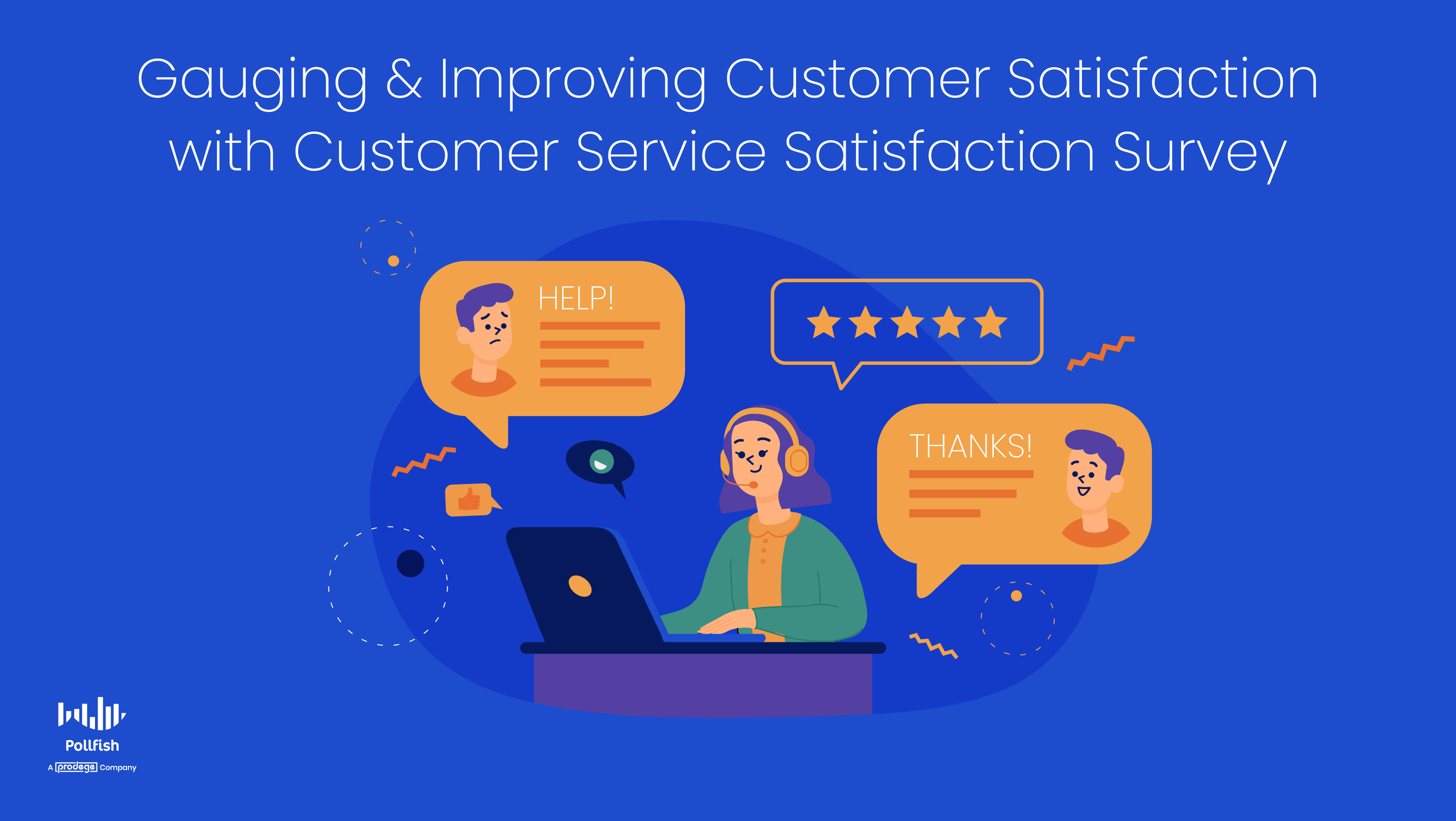
The customer service satisfaction survey is the chief tool to use to assure you offer the best customer service sessions. Your customers are bound to elicit customer service activities with your business, no matter how well they know your products.
Whether it’s for technical support, a glitch in a product or help with your digital properties, seeking out and receiving customer service is a major part of your customer experience. It can occur in all parts of the customer buying journey, including pre-sales and post-sales periods.
As such, you’ll need to optimize your customer service satisfaction, just as you would with any other part of your CX. This is also because customers don’t keep their brand perception to themselves.
72% of customers will share a positive customer service experience with 6 or more people. However, unsatisfied customers also share their experiences; 13% of unhappy customers will share their experiences with 15 people or more.
To take matters into further perspective, 70% of customers say they’ll support a company that delivers great customer service. 17% of Americans are even willing to pay more for a business that has a good reputation regarding its customer service.
These statics prove the weight that customer service satisfaction has on businesses. You can optimize yours by gauging this experience through surveys.
This article explains the customer service satisfaction survey, its importance, when to use it and how to create one.
Understanding the Customer Service Satisfaction Survey
The customer service satisfaction survey is a survey that inquires into customer service satisfaction, as its name suggests. It is a kind of customer service survey, but it should not be mistaken for one, as there are a few distinctions between the two.
The customer service survey is a broader survey type that can be used across the customer buying journey, whereas the customer service satisfaction survey specifically focuses on the satisfaction portion of a customer service session. In this regard, this survey zeros in on support sessions, which are typically conducted after a customer has already made a purchase.
However, this is not a fast and hard rule, as there are other instances in a customer journey where customers receive customer service. Businesses will need to probe them on their satisfaction with these experiences as well.
As such, this kind of survey is centered on gathering customer feedback on the satisfaction aspect of various kinds of customer service. Businesses can use it to measure customer happiness and dissatisfaction during the service session, learn how to improve their service and discover how to streamline future customer service sessions.
When it comes to differentiating from other customer satisfaction surveys, the customer service satisfaction survey entails using customer service representatives to help come up with the questions. This is because you’ll need to use questions specific to the customer service session; otherwise, your customers won’t want to take part in the survey, as it will come across as too generic and not useful to their situation.
The Importance of the Customer Service Satisfaction Survey
The customer service satisfaction survey is critical to use for a number of reasons, including the ones mentioned in the intro.
To piggyback off of the intro, the importance of this survey comes into play, given that you can use it to improve your overall customer experience. Given that customer service sessions involve interacting with a company, usually for an extended period, it plays a major role in CX.
In fact, 1 in 3 customers will leave a business they love after only one bad experience, while 92% would completely abandon a company after two or three negative interactions. There are many things that contribute to a bad customer service experience — some aren’t as obvious as others.
This is where the customer service satisfaction survey is useful, as it helps you find the things that bother your customers, ones which you may have overlooked or never had considered as sources of problems.
A poor customer service experience can be due to the lack of a follow-up. In this case, businesses that have time-poor employees are at a disadvantage, unless they commit to following up with the customers they’ve assisted in a customer service session.
However, even if you follow up with customers you’ve assisted, the customers themselves may lack the time and will to speak with you, if it’s over the phone. Emailing customers is the easy route; however, they may be unwilling to begin an email conversation with customer service agents.
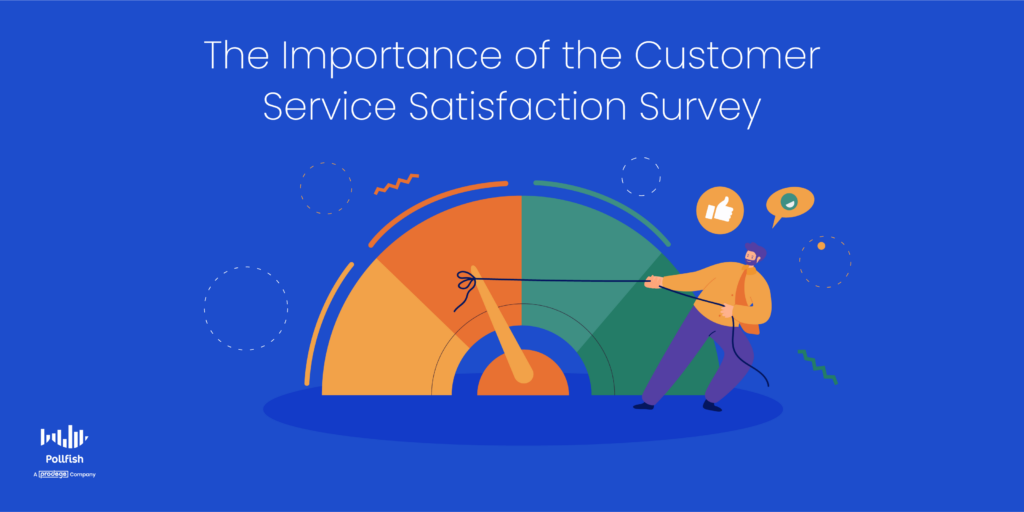
In such a case, the customer service satisfaction survey is especially useful, as it provides a quick and easy method to follow up with your customers after a customer service session. You’ll show your customers you care about their opinions on their customer service experience without asking them for too much time while reaping the benefits of their insights.
As such, this survey helps build connections between you and your customers. The stronger your connection with customers, the more they’ll rely on your products and services. As such, this survey can be used as a tool that goes beyond merely learning about how satisfied customers were with the customer service they got. It also doesn’t stop at improving your CX. Instead, by building relationships with customers, you’re also building brand trust, the cornerstone of consumer loyalty.
Loyal customers are far more inclined on making repeat purchases than causal customers. These are the most quality customers you can strive for, as they will continuously purchase from your brand and even become brand advocates. Loyal customers also tend to have a higher Customer Lifetime Value (CLV).
Given that this survey can help foster brand loyalty and a high CLV, it will in turn lower customer attrition along with your customer churn rate, as you are retaining your customers.
All brands should use the customer service satisfaction survey, as it can reveal critical insights on how to improve your customer service.
When to Use the Customer Service Satisfaction Survey
You’ve probably had various kinds of customer service sessions with your customers. Sometimes, what may appear to be a regular in-store or online encounter, such as a chat, turns out to be something more significant, as it involves customers interacting with your support or sales employees for a considerable amount of time.
Or, it may be quick, but provided invaluable help for your customers. These qualify as customer service sessions as well.
This begs the question of when is the best time to send a customer service satisfaction survey.
The following lists the most apt times to send a customer service satisfaction survey:
- After any situation in which a customer received assistance from an employee, whether it is a customer service employee or others.
- This can involve solicited help, in which customers set up a call or at-home meeting with a representative, or when your employees approach the customers.
- Directly after a scheduled meeting, phone call or other customer service session.
- It is best to let the customers know that you intend to survey them by emailing them.
- This is also a good time to collect their email addresses if you haven’t already.
- This usually occurs after a customer has purchased from you.
- After a customer sampled your product at a store and spoke with a sales representative.
- This occurs usually before a customer has made a purchase and is still deliberating whether to buy from you or a competitor.
- This is a good opportunity to understand customer satisfaction with your customer service in the early stages of your customers’ relationship with you.
- After an impromptu customer service chatting session.
- Some chatting sessions can be minor, with customers asking basic questions that can be found elsewhere on your website.
- But others are more significant, granting key information to customers about all your offerings.
- This can occur at various places in the customer journey, from pre-sales, to after a recent purchase and well after purchasing.
- After customers interacted with a Voice of the Customer (VoC) program, such as a phone call, or in-person experience.
- At times, your support employees may offer specific customer service during these times, so these sessions can extend beyond customers’ venting about their issues or other feedback.
- You can frame the survey as being sent to better help the customers further, even after they gave their VoC feedback.
How to Create a Customer Service Satisfaction Survey
There are various instances where you’ll need to use a customer service satisfaction survey, as the above section explains. They will help you gauge how satisfied your customers are at different points of being served.
If you’re not sure how to go about creating this survey and need a few pointers, the following will guide you.
The following explains how to create a customer service satisfaction survey in a step-by-step way. Check out how to create customer service survey questions.
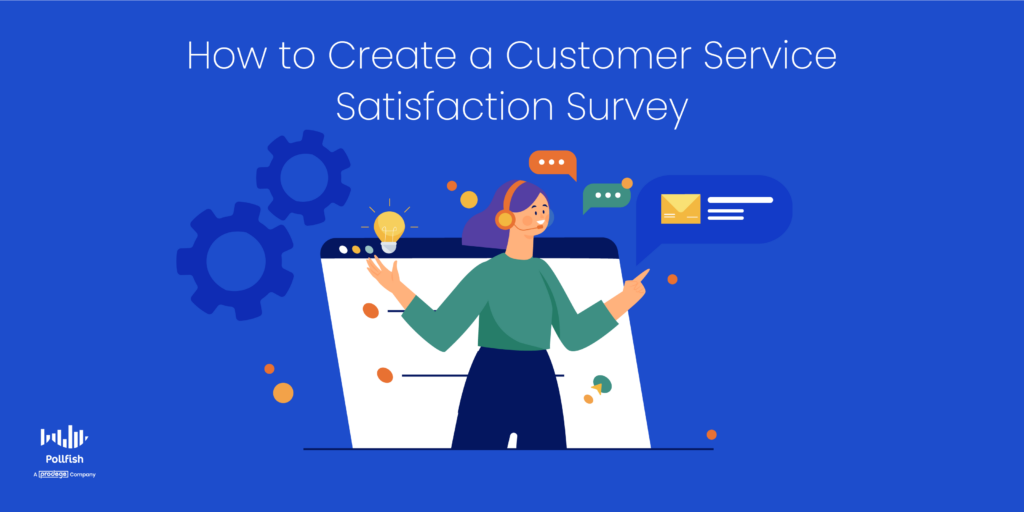
- Determine a recent instance with a customer, in which they received customer service.
- Refer to the above section to help you decide what to accomplish with your customer service satisfaction survey.
- Decide on the correct online survey platform.
- There is a swath of online survey tools but they don’t all offer the same capabilities, user-friendliness and speed to insights as does Pollfish.
- In the screener section of the survey, select the demographics, location and other traits with which you're going to qualify the respondents of the survey.
- Use screening questions to select respondents even more granularly, by qualifying only those who answer in a particular way to take the survey.
- Form a few key preliminary questions for the questionnaire portion and guide the direction of your survey.
- These should be based on the nature of the customer service.
- Choose the survey type you need for your campaign.
- In the questionnaire section, add in your preliminary questions. Choose from a multitude of types of survey questions.
- Create both general questions and those that are very specific to the customer service session you had.
- Your customer service representative will need to come up with the questions.
- As such, this kind of survey will involve more than just your analysts and market researchers, as it will require forming specific questions from sessions with your customer support team.
- Use advanced skip logic to route respondents to relevant follow-up questions based on their answers.
- With skip logic, you can ask a quantitative question using multiple choice and follow-up with a qualitative, open-ended question.
- Create both general questions and those that are very specific to the customer service session you had.
- Always make the survey unique to your brand if you send it to specific people instead of mass-sending it as in Step A.
- Write an effective email invitation by mentioning the importance of the survey and the fact that you value your customers’ time.
- You can include survey incentives.
- Include a call to action (CTA) to an online survey, such as one that exists on a landing page, or post-checkout.
- Be sure it stands out to your respondents.
- Thank your customers for taking your survey with follow-up emails and a “Thank You” on the final page of your online survey.
- Analyze your survey and use it to make changes to improve your customer service satisfaction.
- This may include changing your customer service representatives’ tone of voice, their introduction statements to the customers, etc.
- This may also lead you to omit certain things your customer service representatives currently use when assisting your customers.
Forging the Most Satisfying Customer Service Meetings
There are various key aspects that makeup of customer experience; customer service sessions are one of the most important factors, as these meetings allow customers to resolve issues, ask key questions about your products and services, acquaint themselves with your offerings and virtually anything else related to customer service.
You’ll need a strong market research platform to host your customer service satisfaction survey campaigns. The platform you use should also allow you to survey anyone. As such, you’ll need a platform with a reach to millions of consumers, along with one that offers the Distribution Link feature.
This feature will allow you to send your survey to specific customers, instead of only deploying them across a vast network.
It is also important to use a mobile-first platform, as mobile dominates the digital space and no one wants to take surveys in a shoddy mobile environment.
The online survey platform you opt for should also offer artificial intelligence and machine learning to remove low-quality data, offer a broad range of survey and question types and disqualify low-quality data.
With an online survey platform with all of these capabilities, you’ll be able to measure and improve your customer service satisfaction survey.
What is a Research Panel and is it Necessary for Market Research
What is a Research Panel and is it Necessary for Market Research

A research panel is a frequently used means for conducting research, including market research (the study of your customers). This method involves studying the same group of opted-in participants through various methods and stages that are developed as part of a research campaign.
The technique that underpins a research panel counters organic sampling, which seeks out research participants, particularly survey respondents, in their natural digital habitats. As such, a research panel is an alternative to random sampling and has various differentiations.
You ought to know all the differentiators of research panels, how they stray from organic sampling, as well as what makes a research panel tick.
With this key information at hand, it will make your research endeavors simpler; it will also allow you to choose the best research method. This is a must, considering that there is a wide range of market research techniques. Panels are just one of many.
You may be wondering if panel research is a viable research method for your business needs or research campaign. Or, you may consider using it in tandem with another research technique or tool.

Luckily, we’ve got you covered on this topic.
This article explains the concept of the research panel in full depth, which can serve as a possible avenue market researchers can explore within the vast array of market research techniques.
What is a Research Panel and is it Necessary for Market Research? Table of Contents
- Defining the Research Panel
- The Role of a Research Panel in the Market Research Process
- When to Use a Research Panel</a
- The Pros and Cons of a Research Panel
- Research Panel Examples
- Why Online Polling Software is Better
- The Online Survey Tool: A Stronger Alternative
- What a Machine-Learning and AI-Powered Survey Tool Does for Your Market Research Campaign
- The Ultimate Verdict on the Research Panel for Market Research
Defining the Research Panel
A market research panel is a pre-recruited and pre-screened group of research participants who have opted in to take part as the studied subjects of a market research campaign.
This kind of research method can involve studying its members repeatedly. In this case, the particular study is called a panel study.
It is also referred to as a longitudinal study, although longitudinal studies don’t necessarily need to involve panels, as there can be longitudinal surveys completed by non-panelists.
As such, it is a way of describing those who have agreed to take surveys on an ongoing basis, which, in market research, are typically members of your target market.
You can use a research panel for a wide range of subject matters. The members of the research panel can include a wide range of people across multiple sets of populations.
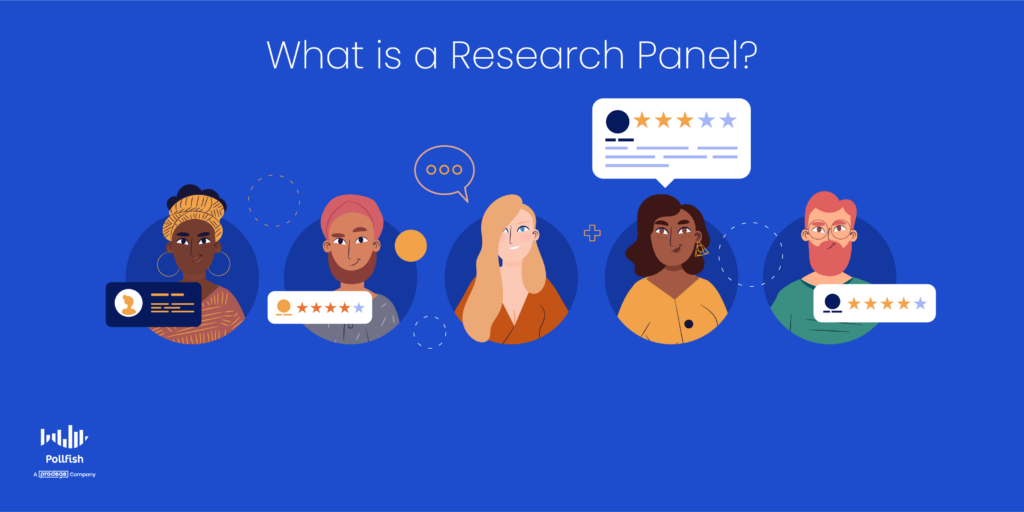
Whether you seek to study the workforce of a company or a major constituent of a national population, the term research panel can apply to all such groups.
The key is to use participants who represent members of your target market and most importantly your target audience also referred to as your survey target audience. That’s because a research panel is a recruitment method used to get respondents to take your survey.
In market research, the participants in a research panel are usually the people who belong to a business’s consumer base.
Moreover, they belong to a particular audience, known specifically as a survey target audience in survey studies. This label can also apply to research panelists, as they too can be asked to take surveys.
The members making up a research panel must share several traits, such as demographics, psychographics, geographic location and more. A market researcher may also study various segments that make up a target market.
There are various methods researchers can employ in their research campaigns, in which a research panel provides insights. These include:
- Interviews
- Focus groups
- Surveys
- In-home usage tests
- Experimentations
- Test marketing
The Role of a Research Panel in the Market Research Process
A research panel is but one process within the encompassing practice of market research. Some businesses may decide to extract data from a research panel alone, while others may use it alongside probability sampling.
Also called organic sampling, this method involves reaching out to all the individuals who fall under the qualifications of your subjects of study. As such, it allows more individuals to take part in the sample.
Unlike many of the sub-methods of organic sampling, a research panel is not anonymous, in the sense that the panelists’ identities will not be hidden from the researcher.
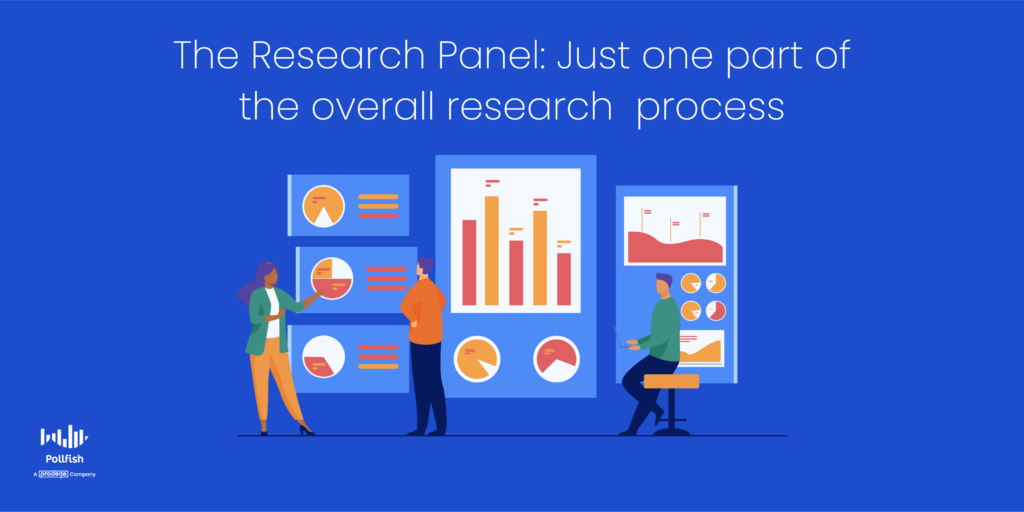
They are still kept anonymous when it comes to sharing the findings with the public, as you wouldn’t reveal the panelists’ identities.
This allows researchers to study the members at a greater depth, in that researchers can match answers with the respondents themselves. This is due to the nature of pre-recruiting participants; when you do so, you’re going to need to collect information on each panelist, some of which may be personal.
This method will allow you to understand if they’re qualified to partake in your studies. As such, you’re effectively putting names and faces with data, essentially identifying each member. Additionally, this allows you to build a profile on each participant, adding bulk by applying multiple studies.
Forming profiles gives you a glimpse into the presence of personas in your target market. A research panel is the starting point in building a persona.
When you’ve profiled panelists through various means (interviews, focus groups, etc.), you have several kinds of data, from which you can form an analysis and draw conclusions.
You can test the prevalence of these conclusions by surveying other members of your target market, i.e., those who are not in the research panel.
Various survey sampling methods will not only complement your research panel but also give it validity and statistical relevance. After all, there are only so many panelists you can interview or meet with.
Even if you study your research panel via surveys, it is not practical to spend a lofty amount of time vetting people to ensure they fit your research campaign. Thus, a research panel may not be the strongest of the various market research techniques.
When to Use a Research Panel
While businesses and market researchers can use a research panel liberally, it is not always in their best interest. This can be due to the size of a business, a limited budget, the objectives of a research campaign and the length of the research study. There are also times when it makes sense to engage in research yourself and other times in which it may be beneficial to work through a professional market research agency such as IntoTheMinds.
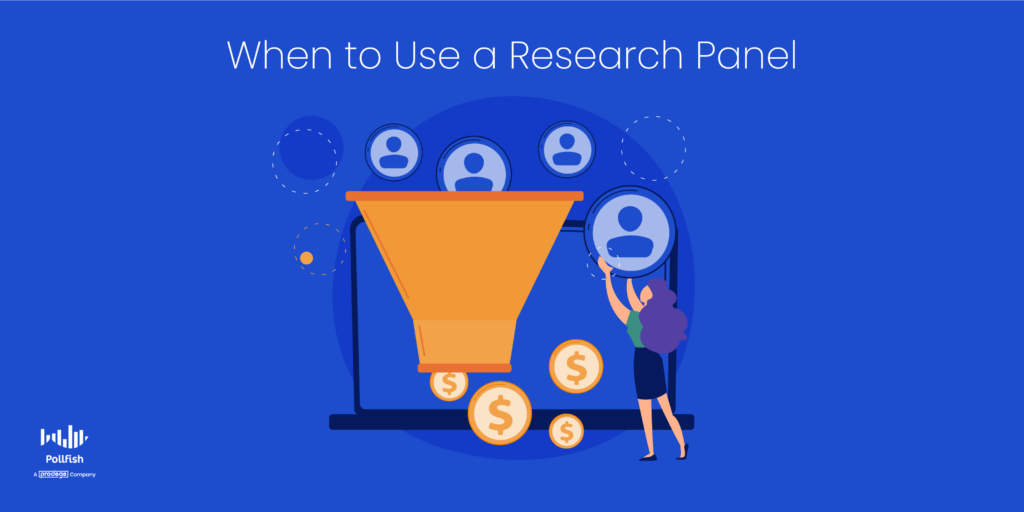
With this in mind, there are particular times in which companies and researchers alike can benefit from using a research panel. These include the following instances:
- Obtaining a constant, in-depth read of a certain group of participants.
- Conducting a more intimate study on a particular group of people.
- Running continuous studies on the same people, ie, for longitudinal studies.
- Gathering data on subjects with scant studies due to rarities. Ex: people aged 100+
- Large research projects that will involve multiple modes of data collection
- When you are performing market segmentation.
- When you are building research or customer personas.
- To fulfill the preference of conducting research in a group setting.
- To gain insights on a topic that you may not have considered from your list of questions/concerns.
- These insights typically arise in conversations, as participants bring up points and considerations that you may not have originally thought of when forming your research plan.
- To assist or act as a helping agent in conjunction with another form of research, such as survey studies.
The Pros and Cons of a Research Panel
The research panel tactic offers advantages and disadvantages that all market researchers should be privy to. Like other research techniques, it is not perfect and for some, the disadvantages may outweigh the benefits, while to other researchers, the opposite may be true.
You should mull over both the advantages and disadvantages that come with this form of research.
The following lists the advantages and drawbacks of using a research panel.
The Pros
- Panel members have a more advanced understanding of the research topic since they can be recruited through a longer vetting process.
- It can be used multiple times on the same survey, to study change within a particular group that represents segments of your target market.
- It’s easier to conduct in recurring intervals, given that you have all the panelists’ information and don’t need to screen them as you would with a new set of participants.
- Deeper reads and longer researcher/panelist interactions are suitable for the 3 main types of survey research methods.
- It is much easier to follow up with panelists, should you need more research, as you already have their contact information.
The Cons
- Lack of privacy: face-to-face interviews, along with phone interviews in which researchers know the identities of panelists can be intimidating.
- Even a panel study lacks privacy, which can lead to intimidation or fear of answering honestly.
- Acquiescence bias: along with other biases, this issue can take shape, as respondents may feel pressured to answer in a particular way, leading to forced or inaccurate responses.
- Panel attrition: Due to re-interviewing, research panels are susceptible to fatigue, loss of interest, or pressure (Points 1, 2), making them easy candidates for attrition.
- Ingenuine change of attitude/ opinion: Interviewing and reinterviewing can change attitudes, in ways that are not always genuine, due to re-interviewing.
- Expensive: Whether you hire an in-house panel or use an external one, it is often an expensive affair, as you will need to pay each panelist. Since this is an ongoing study, you may have to pay them for each session.
- Poor data quality: This is especially true when a panel member is a participant in multiple panel companies.
- The quality of the data may be compromised when a respondent is a member of two or more panels.
- This is because the respondent may partake in the same survey.
- If they answer the same way, you will have duplicate data, but if they answer differently, there might be bias. At any rate, you’re getting data from the same person twice, which doesn’t improve the trustworthiness of research findings.
- Missing out on a larger survey pool: This relates to the aforementioned lack of privacy. Not everyone in your target audience will want to give away their contact info, let alone have their answers be tied to their identity.
- As such, you may not get enough participants for the specific quantity required for your survey sampling size.
Research Panel Examples
A research panel can be applied to all kinds of scenarios and has various use cases. Remember, they can be applied to both long and short-term research, despite being associated with the former more often.
They can be used in market research, which is for business purposes and is centered on customers. Or, they can be used for a wide range of other research types, such as medical, scientific, social, behavioral and educational research.
To help you better understand research panels, the following list includes seven examples of them across different areas of study:
- A business studying the customer buying behavior of three of its customer market segments.
- This is especially useful to compare segments with high and low consumer loyalty.
- A university research group studying the effects of sleep deprivation among students over a semester or year.
- An enterprise company seeking to release the most resonating ad campaigns by comparing how it's received across the world.
- A condiment manufacturer who is interested in comparing flavor and texture preferences across different parts of the country.
- A business that is intent on following its target market’s shopping habits and how they compare to their competitors.
- This will need to involve research on competitors. That means you’ll need to inquire about them in the panel, as well as perform secondary research to complement the study.
- A healthcare company seeking to find the relationship between device usage and obesity.
- A government program that tracks the success of a new social program for certain populations.
Why Online Polling Software is Better
Online polling software trumps research panels for a variety of objective reasons. There are also various subjective and preference-based justifications for leveraging an online survey tool instead of a research panel.
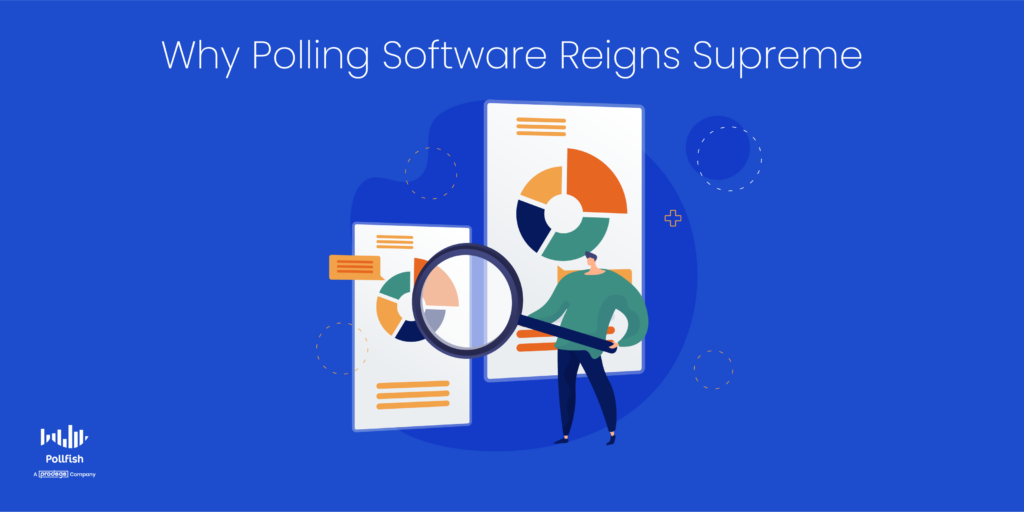
Organic Sampling and RDE
First off, online survey platforms allow you to run random organic sampling, which allows you to reach non-professional survey takers and gain a far larger reach than you otherwise would have.
This is because organic sampling involves what’s known as Random Device Engagement (RDE), a kind of polling that relies on advertising networks and other portals on devices, to engage random people where they are, voluntarily.
Additionally, in Random Device Engagement, the surveys are delivered to users in their natural digital environments, capturing them where they prefer to be. They were not pre-recruited and thus do not face the same pressures and conditioning that they would in a research panel.
As such, they are more likely to answer questions truthfully, as they have no one to answer to, are kept anonymous and have nothing to lose.
Greater Privacy
With far more privacy afforded to them, respondents of organic sampling surveys are also less vulnerable to acquiescence bias and all the other biases that involve the respondents’ reputation.
On the other hand, there’s polling software. This method, as aforesaid, provides respondents with the most privacy, as they are not pre-recruited or pre-screened. In many cases, polling software reaches respondents organically, which affords respondents the most amount of privacy.
Some survey platforms (such as Pollfish), allow you to send surveys to specific individuals instead of simply across a vast network of online platforms; in this case, the study won’t be as private. However, it is another deployment option to expand how you run your survey study.
Greater Reach to Research Participants
It also has a far greater reach to respondents. This, however, will depend on the online survey platform you use. We suggest one that allows you to conduct global surveys with the same ease as you would with local surveys.
Upfront Incentives
When you use an online survey platform, survey incentives are usually mentioned upfront. This is typically the case with a survey platform that partners with gaming sites and other digital platforms that offer in-app awards, which can be either monetary or non-monetary.
With incentives being offered (or at least mentioned) at the fore, all kinds of customers will be more willing to participate in the survey study.
Less Time Consuming
Moreover, an online polling platform isn’t as time-consuming for respondents. This is because such a platform does not simply conduct longitudinal studies — and even when it does, it can target random people who fit into certain customer profiles and customer personas.
It is also far less time-consuming for researchers. That’s because they don’t need to conduct interviews or other actions to recruit participants; the polling software does it for them. As such, it’s a win-win for all the people involved in the study: the respondents and the researchers.
Less Room for Attrition, Boredom and Bias
As such, it isn’t reliant on using the same people repeatedly to take part in a study. In this way, it cuts survey attrition. This is because some panel members may feel exhausted, burned out or simply frustrated with having to continuously be part of a study, especially if it covers the same subject.
As such, using polling software grants you the opportunity to ward off boredom from your respondents, as well as gain accurate responses. As mentioned earlier, panelists are far more prone to acquiescence bias and other biases.
Respondents of a polling platform offering organic sampling are at a far lower risk of being biased or getting bored. The latter is especially true in a platform that offers a mobile-first environment. After all, mobile dominates online web traffic, as over half of web traffic comes from mobile devices.
Thus, a good survey design, especially one built for the mobile space creates a pleasant survey experience, one that intrigues respondents to take a survey in the first place, and most importantly, complete it.
Aside from these advantages that online polling offers over research panels, there are many more. The other pros deal largely with the survey tool itself as opposed to its distribution and high-level polling aspects.
The Online Survey Tool: A Stronger Alternative
While a research panel has several benefits and use cases, online survey tools present a stronger alternative. First off, they have even more use cases and can be applied to all with greater ease.
This is because the survey tool itself does all the recruiting and screening for you. As a researcher, marketer, or business owner, you don’t have to worry about whether your survey respondents fit your target survey audience’s qualifications.
Identifying and acquiring respondents are both taken care of by an online survey platform, that is if you choose a potent one. This means you don’t need to have a pre-study interview to vet potential participants. Instead, everything is automated.
A strong online survey platform offers machine learning and artificial intelligence software to run all of its functions and mechanisms. This means, there is little to no manual labor required on your part.
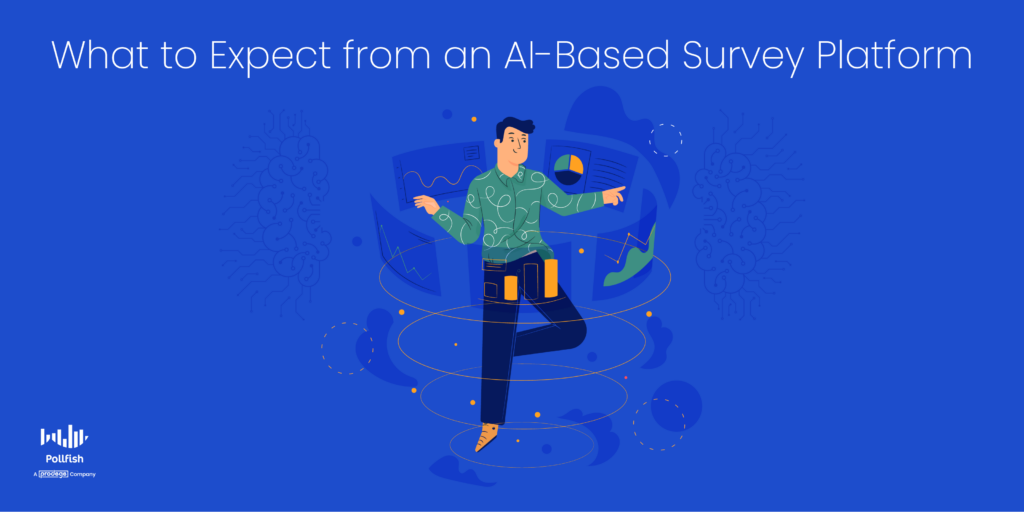
All you need to do in your survey campaign with a strong online survey tool is:
- Set your screener so that your survey targets the correct populations
- Create your questionnaire
- Analyze the survey
Those are the three steps involved in the Pollfish platform. If you’d like to learn how to make your own survey in just 3 easy steps, read the article in the hyperlink.
The online survey platform should handle all the rest. When it comes to running a high-quality market research campaign, there is a lot that goes into staving off poor-quality data and ensuring accurate results.
The following lays out what an AI-powered survey platform can do for your survey campaign:
What a Machine-Learning and AI-Powered Survey Tool Does for YOur Market Research Campaign
A lot is going on behind the scenes of an online survey platform. Luckily, you won’t have to worry about nearly all of them. Regardless, it is crucial to understand the depth of survey SaaS that runs on machine learning and artificial intelligence.
Here’s what to expect from an AI-based survey platform:
- A strong adherence to targeting
- No respondent partially matches the demographic and psychographic screening that the researcher inputs into the platform.
- All survey participants must match 100% of the respondent qualifications. If not, they are disqualified from taking the survey, no matter how close to filling all slots of the criteria they get.

The Audience section on the organic sampling survey platform Pollfish has a rigid adherence to granular respondent targeting.
- Respondent verification
- This mechanism checks respondents for duplicated IDs to ensure each survey completed is done by a unique person, as opposed to one person taking a survey more than once.
- The platform checks IP and MAC addresses, Google Advertising and mobile device identifiers.
- In addition, the platform works with vetted publishers to send unique IDs as an added layer of protection against survey fraud.
- A layer of security in the questions themselves
- In-survey questions are designed as yet another layer of security against survey fraud.
- For example, a question can request respondents to answer a simple math problem.
- Or the survey would include identical questions with the response options re-ordered to verify answer consistency.
- Antibot Policy
- Bots are no match for an AI-powered platform that is designed to disqualify them from taking a survey.
- Zero tolerance for VPNs
- Most businesses and research campaigns put qualifications based on geographies.
- A respondent on a VPN would tarnish any study with filters on who gets to partake in the survey based on location.
- The Pollfish zero-tolerance approach to VPNs ensures the veracity of respondents’ location.
- Removal of incomplete surveys
- This speaks for itself, as surveys are meant to be fully completed. A partially complete survey would provide insufficient data.
- Incomplete surveys are especially problematic in surveys with follow-up questions to past questions, or those seeking more depth to a certain issue.
- Removal of surveys with suspicious activities
- Surveys with any questionable behaviors are rejected.
- This includes the removal of the following:
- Answering open-ended questions with nonsense
- Attempting to sign in from multiple countries/devices at once.
- Taking an inappropriate amount of time on the survey.
- Multiple layers of quality checks
- The survey platform uses a technical layer to perform other quality checks.
- This process includes our technical experts continuously working to avoid survey fraud.
- There are several layers that we use to maintain good data quality. These include checks on the following:
- Hasty answers Check: catches respondents who answer faster than the average time needed to read the questions.
- Reset ID Check: Activates when the respondent answered the same survey previously, but with a different device to avoid the same respondent from taking the survey more than once.
- Gibberish Check: Checks for answers contain nonsensical text. This is the kind of text without real words, such as “jnfjv vdf gre.”
 Avoid receiving gibberish answers thanks to the Pollfish AI-powered survey platform
Avoid receiving gibberish answers thanks to the Pollfish AI-powered survey platform - Same IP Participation: Checks if a survey has been completed before within a certain time from the same IP address of the respondent’s device.
- Carrier Consistency: Assures that the carrier of the respondent’s internet service exists in the targeting market.
- Specialized questions to identify those not paying attention
- Aside from a layer of security in all questions, we offer specialized questions that detect poor data quality.
- These include the following question types:
- Red herring questions: Asks questions with odd answers to assure respondents are paying attention.
- Trap questions: Finds who is paying attention to a command, usually one that asks to select a negative response. Responders who choose positive responses will be caught.
- Quality Questions: Similar to red herring questions, they check if respondents read and understand what’s being asked.
- Constant iteration until all quotas are met
- With the agile research approach, the platform doesn’t merely provide speedy insights.
- Instead, it creates constant iterations until all the quotas and the desired amount of completed surveys are met.
- As such, the platform doesn’t cease, or pause (unless you set this command on your dashboard).
- It allows you to gain the proper amount for your sampling pool.
- With this, no survey pool is too large (relative to the necessary sampling size).
How else do research panels compare to an online survey platform?
Respondents can rest assured that they do not need to give away their data. To add to this, they can still be incentivized to take part in a survey study.
An online survey platform does all the heavy lifting in terms of retrieving responses, while in a research panel, the researcher has to make sure that all the participants respond adequately. This is to say that the researchers themselves must check for gibberish answers, questions left unanswered and much more.
This is especially more difficult in focus groups and one-on-one interviews, in which a researcher has to make sure everyone participates in the former, and that the panelists are willing to truthfully answer all the questions in the latter.
An online survey tool also effectively eliminates the need to worry about survey response rates, as it keeps iterating until the preset requirements are met (including the number of respondents).
As such, researchers have plenty to gain for their research needs from using an online survey tool in tandem with a research panel, or even as a replacement for a research panel.
The Ultimate Verdict on the Research Panel for Market Research
A research panel is a useful method for conducting market research, particularly for studying the same group of participants to monitor their opinions and behaviors and changes thereof.
However, a productive market research campaign will rely on using more diverse methods to extract data. This involves using random organic sampling, which forgoes the conditioning and pressures of a research panel.
As such, you should opt for a survey platform that offers RDE, or Random Device Engagement, which, as mentioned earlier on, distributes surveys randomly, across a wide network of digital properties. This includes websites, mobile sites and mobile apps.
With this survey function, the platform does all of the work when it comes to identifying respondents and covering all quotas. That means you don’t need to do anything in this regard, as the platform performs these tasks.
But there’s more.
To piggyback off of the section on the role of the research panel, online surveys and research panels do have some beneficial similarities. For example, they’re both ideal for creating and validating personas.
A research panel can identify a persona over several rounds of interviews/ surveys/ etc., while an online survey tool can conduct further research to find whether those personas are statistically significant.
Thus, these methods work well hand-in-hand when it comes to conducting market research. A strong online survey platform will ensure a synergistic relationship between random sampling surveys and research panels.
It should allow you to survey specific people, such as via email, or whichever digital channel you seek to use. Luckily, there’s the Distribution Link feature, which enables you to do just that.
Frequently asked questions
What is a research panel?
A market research panel includes participants who have willingly opted to participate in a research group regarding a specific subject. These members are pre-screened and pre-recruited.
Why are research panels important in the market research process?
Research panels are essential because they are not anonymous, unlike the respondents who take the surveys incognito. This is important because it allows researchers to find out everything about the members to match answers with the respondents themselves, ruling out chances of inaccuracy.
When should businesses use a research panel?
Businesses should set up a panel to facilitate in-depth research of audiences and their behavioral patterns or conduct a detailed, intimate study on customers. Large research projects that require multiple modes of data collection or market segmentation also work well with a dedicated research panel. You can also use them when building customer profiles.
What are some pros of using a research panel?
Panel members usually have a more advanced understanding of a research topic. Research panels are also easy to conduct in recurring intervals, and researchers do not need to screen information as they would with a new set of participants. In this way, it is faster and more efficient.
What are some cons of using a research panel?
With a panel, participants do not have privacy. They may have to participate in interviews which can be intimidating. This may pressurize a respondent to answer in a particular way, leading to an incorrect response. Research panels are also prone to fatigue, loss of interest, and panel attrition. Also, hiring a research panel is usually costlier as you may have to pay the participants for every session.
New Demographic and Targeting Criteria on Pollfish
New Demographic and Targeting Criteria on Pollfish
We're constantly innovating our market research platform to equip you with strong survey research methods and the best survey experience for your respondents.
The first step to creating a survey in Pollfish is selecting your target audience. However, choosing a target audience can be a challenge if you’re unsure which segments are available or how to get started.

To ensure you’re reaching the right respondents, we’ve provided a full list of all the ways you can segment and select your target audience.
Targeting by Gender
- Male
- Female
- Gender Quotas
- Other
We've updated the Gender targeting filter on the Audience page. The Gender filter now includes a new choice — "Other'' — a non-binary gender option.
The option will not be preselected. if the researcher enables it. It has no additional cost, much like the 16-17 age range. Thus, the maximum price of the gender filter is also not affected. If your results include respondents identifying themselves as ''Other,'' post-stratification will not be available on the results page
The researchers can select the ''Other'' option along with making quotas in the gender filter.
Targeting by Age Range
- Six preset age groups (16-17, 18-24, 25-34, 35-44, 45-44, 54+)
- Specific Age groups (Min/Max)
- Age Group Quotas
Your survey begins with age and gender targeting included.
Targeting by Geolocation
- Country (over 160 countries available)
- City
- Region/ State
- Radius (from physical location)
- Residential Postal Code
- US Postal Code*
- US Census Region*
- US Census Division*
- US Congressional District*
- US DMA*
*Available in United States only
Residential Postal Code
This filter will be based on the data you collect through our demographic portion of the survey (at the demographic info collection section in the screener). Hence, the respondents will declare their location in response to the demographic question of ''What is your zip code?'' since the filter will be global originally.
In addition, we allow researchers to target either by residential postal codes only or by the other geolocation criteria available on the Audience page. This includes targeting by respondents based on their country, city, radius, zip code, etc.
You can contact Pollfish to enable Residential Postal codes on your account.
Targeting by Demographic Criteria
Pollfish asks each respondent to complete a profile in advance of taking their survey and uses rolling profiling to ensure that answers are up-to-date. Targeting can be used to reach people meeting any of the following criteria.
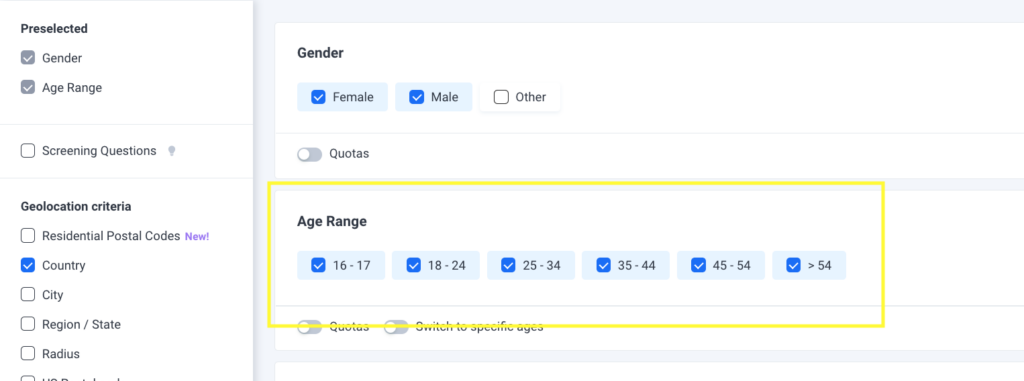
Marital Status:
- Single
- Married
- Divorced
- Living with Partner
- Separated
- Widowed
- Prefer not to say
Number of Children:
- None
- One
- Two
- Three
- Four
- Five
- Six or more
- Prefer not to say
Education:
- Middle School
- High School
- Vocational/ Technical College
- University
- Post-Graduate
Employment:
- Employed for wages
- Self-employed
- Unemployed and looking for work
- Unemployed but not currently looking
- Homemaker
- Student
- Military
- Retired
- Unable to Work
- Other
Career:
- Agriculture Forestry Fishing or Hunting
- Arts and Entertainment or Recreation
- Broadcasting
- Construction
- Education
- Finance and Insurance
- Government and Public Administration
- Health and Social Assistance
- Homemaker
- Hotel and Food Services
- Information—Other
- Information—Services and Data
- Legal Services
- Manufacturing—Computer and Electronics
- Manufacturing—Other
- Military
- Hotel and Food Services
- Processing
- Publishing
- Real Estate, Rental, or Leasing
- Religious
- Retail
- Scientific or Technical Services
- Software
- Telecommunications
- Transportation and Warehousing
- Energy/ Utilities/ Oil and Gas
- Wholesale
- Advertising
- Automotive
- Consulting
- Fashion/ Apparel
- Human Resources
- Market Research
- Marketing/ Sales
- Shipping/ Distribution
- Personal Services
- Security
- Other
Race/ Ethnicity:
- Arab
- Asian
- Black
- White
- Hispanic
- Latino
- Multiracial
- Other
- Prefer not to Say
Household Income:
- Lower I
- Lower II
- Middle I
- Middle II
- High I
- High II
- High III
- Prefer Not To Say
Household income mapping varies by country. To see how this breaks down, see the full list under household income criteria by country.
Number of Employees
- One
- 2-5
- 6-10
- 11-25
- 26-50
- 51-100
- 101-250
- 251-500
- 501-1000
- 1001-5000
- 5000+
- I don’t work
- Prefer not to say
Organization Role
- Owner or Partner
- President/ CEO/ Chairperson
- C-Level Executive
- Middle Management
- Chief Financial Officer (CFO)
- Chief Technical Officer (CTO)
- Senior Management
- Director
- HR Manager
- Supply Manager
- Project Management
- Business Administrator
- Supervisor
- Administrative/ Clerical
- Craftsman
- Foreman
- Technical Staff
- Sales Staff
- Buyer/ Purchasing Staff
- Other non-management staff
- Prefer not to say
Targeting by Mobile Device Criteria
OS Platform
- Android
- iOS
- Web
- Windows Phone
Manufacturer
- Acer
- Apple
- Blackberry
- Carrefour
- Samsung
- ..and more. (Due to our rapidly refreshing audience, it’s best to type the name of the manufacturer you are looking for into the dropdown search for the most up-to-date list of who we support)
Mobile Carrier
- AT&T
- B-Mobile (BT)
- Bell
- China Mobile
- T-Mobile
- Telstra
- Tesco
- Softbank
- Sprint
- Verizon
- Vodafone
- ..and more. (Due to our rapidly refreshing audience, it’s best to type the mobile carrier you are looking for into the dropdown search for the most up-to-date list of who we support)
Pollfish offers 3 screening questions to help you define your audience even further. You can also use these to narrow in on specific behaviors, beliefs, or motivations of your target audience. Be sure to check out our post on how to use screening questions effectively to get the most out of them.
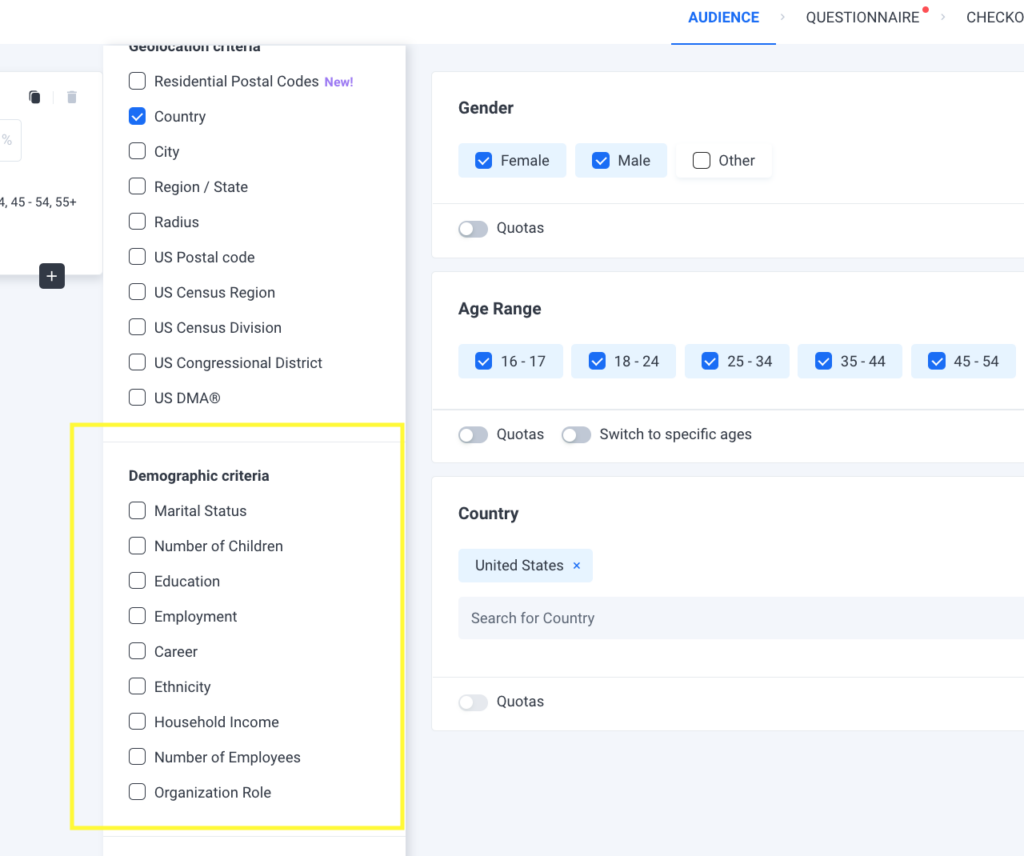
Once you have selected your targeting criteria, you’ll see a preview of your audience makeup on the right side of your dashboard, along with an estimated time to completion. Review how to set up targeting with our video to get started.
https://vimeo.com/304695551
Building Brand Purpose with Market Research
Building Brand Purpose with Market Research

As businesses seek to scale, grow and differentiate themselves from others in their field, they’ll need to have their brand purpose on full display.
Making light of your brand purpose is a critical way to show that your brand is mission-driven and exits beyond the shallow purpose of making a profit. Customers, especially the younger generation are fond of brands with a purpose.
In fact, 92% of Gen Z and 90% of Millennial respondents say they would support a purposeful brand, compared with 81% of Gen X consumers.
Consumers from across the globe also view brands that actively display their purpose in a positive light. 64% of global consumers say brands that communicate their purpose are more attractive. 62% want companies to take a stand on the issues they care about.
This article delves into brand purpose, its importance, examples of companies with visible purpose and how to find and build your own through market research.
Understanding Brand Purpose
This concept refers to a brand’s moral reason for being and what it stands for aside from making a profit and other commercial interests. Typically, a business assumes a brand purpose aligned with what its customers believe.
Also called the North Star and the noble purpose of a brand, it largely deals with finding a reason for the brand’s existence and using it to help its consumers.
Brand purpose is essentially the “why” behind a company. This “why” allows the business to show customers the values it holds and the noble cause it hopes to either achieve or contribute to.
A business’s brand purpose can serve as a reflection of the founders’ lives and experiences, what they consider to be gaps in their market or a major change in their market.
A brand’s purpose can be ethical, moral or political in nature, giving customers the chance to do business with a brand that supports a certain cause or way of life.
A brand purpose should not be confused with a brand promise, which is the general expectation a product or service offers to its customers.
Coming Up With a Brand Purpose
When coming up with a brand purpose, consider how your business intends to make the world improve, or at least a component of it. This can involve affecting social obligations for your target market, environment or society at large.
This will resonate with your consumers and their values and give them another reason to patronize you.
Ask yourself the following to begin finding your brand purpose:
- What does your brand stand for?
- Does your business have a mission?
- What does your business strive to do – or commit to never do?
- What values does your brand uphold or plan on upholding?
- How can you use your values as a company to strive towards a goal for the greater good?
Questions like these are at the core of brand purpose. Once you answer these, you can study your customers to probe further.
The Importance of Brand Purpose
A brand purpose goes far beyond appearing conscientious in your market.
First off, a powerful brand purpose will set you apart from the competition. Plenty of business rivals may offer similar products, services and experiences, but they are unlikely to share the same brand value of your brand — or any at all.
A brand purpose is a potent aspect of your business to use for building your reputation and strengthening your brand equity. You can do so by establishing your brand as one that is socially, environmentally, politically or otherwise conscious and caring about issues besides its own bottom line.
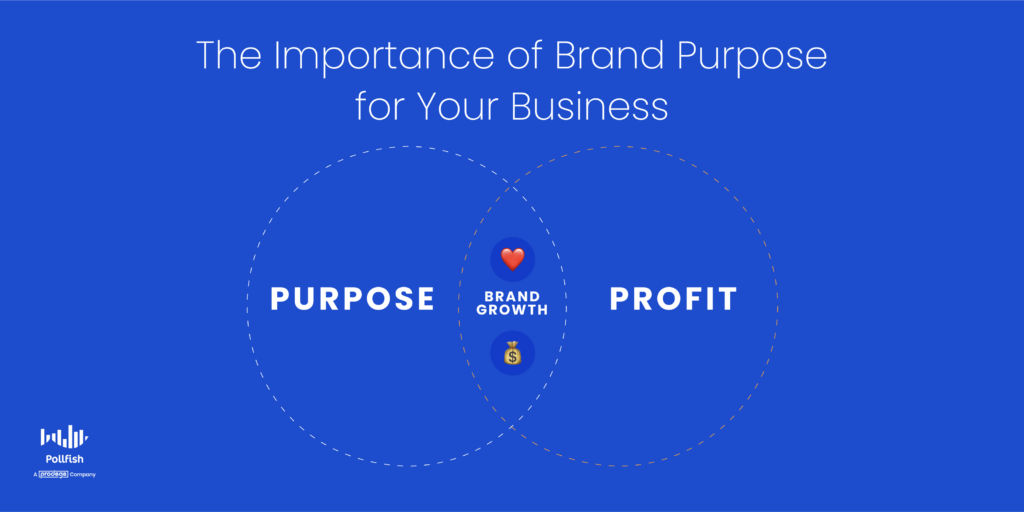
In turn, this humanizes your brand. Your business will no longer be seen as merely another provider or another cash cow. Instead, it will be recalled as one with a human conscious, one that cares bout a certain issue and it attempting to reach goals that ultimately benefit society in one way or another.
By improving your reputation and heightening your brand as one not solely concerned about profits, you can thus apply your brand purpose in your branding. You can do this across a wide span of campaigns, from branding to PR to advertising and beyond. Your best bet is to apply it to the main conduit of your communications: your content marketing strategy.
This involves directly mentioning your purpose and alluding to it across your blogs, resources pages, social media, landing pages, videos and any other channel that grants you the opportunity to make consumers aware of your brand purpose.
Finally and most importantly, having a brand purpose makes the brand more appealing to the customers, as they will feel that their spending is making a difference in the world. It will also make them feel like they are a part of something greater than just a customer buying journey or shopping session.
A brand purpose enables your business to connect with consumers on a personal level. This is important, as aforementioned, given that customers are becoming increasingly invested in brands that have a purpose.
In fact, 52% of customers say they are more attracted to buy from brands if they stand for something bigger than just the products and services they sell, especially if it aligns with their personal values.
Moreover, 71% of customers say they prefer to buy from a purpose-driven company over another one, should the cost and quality be the same. What’s more astonishing is that despite the statistics of consumers leaving brands after one bad experience, 72% of consumers say they would forgive a company with a brand purpose if it made a mistake.
The implications of these statistics are major, pointing to higher levels of brand trust in purposeful companies. Additionally, it means that when a customer contemplates a brand with purpose, they are also more inclined to remember it, purchase from it and want to work for it.
In addition, when a customer sees a logo of a purpose-driven brand, they’ll associate it with being compassionate, responsible and ethical.
All in all, when brands exhibit a brand purpose, they are effectively standing out among competitors, improving their reputation, gaining ideas for marketing and branding and resonating with customers and their values.
All brands should therefore strive to be purpose-driven.
Examples of Companies With Brand Purpose
Companies across various sectors have taken up a brand purpose. This has given their customers a much deeper meaner to their brand and offerings.

The following lays out a few examples of companies that actively demonstrate their brand purpose:
- Dove: The personal care company aims to help women discover the value of real beauty and improve self-esteem worldwide. Their #speakbeautiful movement encouraged women to be kinder to themselves and embrace their natural bodies. The brand creates relatable and realistic marketing instead of the highly edited images common in the beauty industry.
- Muji: The Japanese retailer of household items and apparel promotes self-restraint, humility and the natural state of the environment, along with supporting simplicity and moderation. It sustains the latter by offering functional products with a simple design and are practical to use. As for the former, Muji emphasizes reducing production, recycling and packaging waste.
- Crayola: The art supply company works to help parents and teaches foster creativity within children. It enables those in children’s lives to inspire them to be “creatively alive” instead of simply using their products. Crayola had various programs dedicated to this purpose, a mission they attempt to achieve globally.
- Everlane: The American clothing retailer has a threefold brand purpose. It is bent on creating environmentally friendly products, providing high-quality products and being transparent as possible. The company sources only from ethical factories — the kinds that have fair wages and hours. It uses fine materials and brands itself as being radically transparent. When it comes to the latter, Everlane gives information on how much their clothes cost to be made, which materials they used, the labor involved and even the transporting methods.
How to Find and Build Brand Purpose with Market Research
Market research can help you discover the possible themes and nuances of your brand purpose. This is because there are various market research techniques you can use to study your target market, the group of customers most likely to buy from you.
You can begin conducting market research via secondary sources, such as trade magazines, news websites, blogs and competitor websites to see the kinds of purposes your competitors are aligning themselves with.
You can also use these sources to understand which purposes resonate the most with customers and the kinds of campaigns brands in your field and beyond have created based on their brand purpose. This will help you form the onset of your brand purpose.
Next, shift into primary market research by conducting survey research on your target market. This will give you firsthand insights into all of your customers’ thoughts in relation to current issues and popular causes.
Use a trusted online survey platform to reach the correct target market sample. This platform should allow you to extract the exact amount of respondents that you input in the screener, including quotas on various audiences.
Your survey platform should have the option of being able to incorporate multiples audiences in one survey. That way, you can observe different target market segments and customer personas under one survey study, allowing you to analyze the data via the same dashboard.
You should also be able to reach the correct respondents via demographics, behaviors, and even by their specific answers to screening questions.
Ask your respondents about various social issues, from the environment to education and all else. In your survey, you should seek out which issue and which message resonates the most with your target market, along with which elicits the strongest reactions. In this way, you may need to insert elements of emotional marketing.
You should also add A/B testing into your surveys to see which messaging or issues affect your customers the most, along with which they care most about. Remember to conduct market research beforehand, as you’ll need to know your customers before you set out to find your brand purpose.
You can continue surveying customers after you’ve decided on a brand purpose, to find the right messaging and images. Do so with A/B testing, including sequential testing.
Differentiating Your Business
Creating a brand purpose and applying it to various marketing campaigns will differentiate your business and ultimately allow it to survive. But before you insert a brand purpose into your branding, you’ll need to find a strong one that your target market deems important and compelling.
To do so, you’ll need a strong market research platform to host your survey campaigns. Such a platform should run on random device engagement (RDE) sampling, so you can reach customers in their natural digital environments, instead of pre-recruiting them. This removes social pressures in the surveys and will cut back on survey bias.
You should also use a mobile-first platform, since mobile dominates the digital space and no one wants to take surveys in a mobile environment that’s not built for them.
The online survey platform you opt for should also offer artificial intelligence and machine learning to remove low-quality data, disqualify low-quality data and offer a broad range of survey and question types.
It should also allow you to survey anyone. As such, you’ll need a platform with a reach to millions of consumers, along with one that offers the Distribution Link feature. This feature will allow you to send your survey to specific customers, instead of only deploying them across a vast network.
With an online survey platform with all of these capabilities, you’ll be able to motivate your customers into making repeat purchases.
What is a MaxDiff Analysis? The New Best-Worst Scaling Feature
What is a MaxDiff Analysis? The New Best-Worst Scaling Feature
How to Promote Repeat Purchases with Survey Research
How to Promote Repeat Purchases with Survey Research
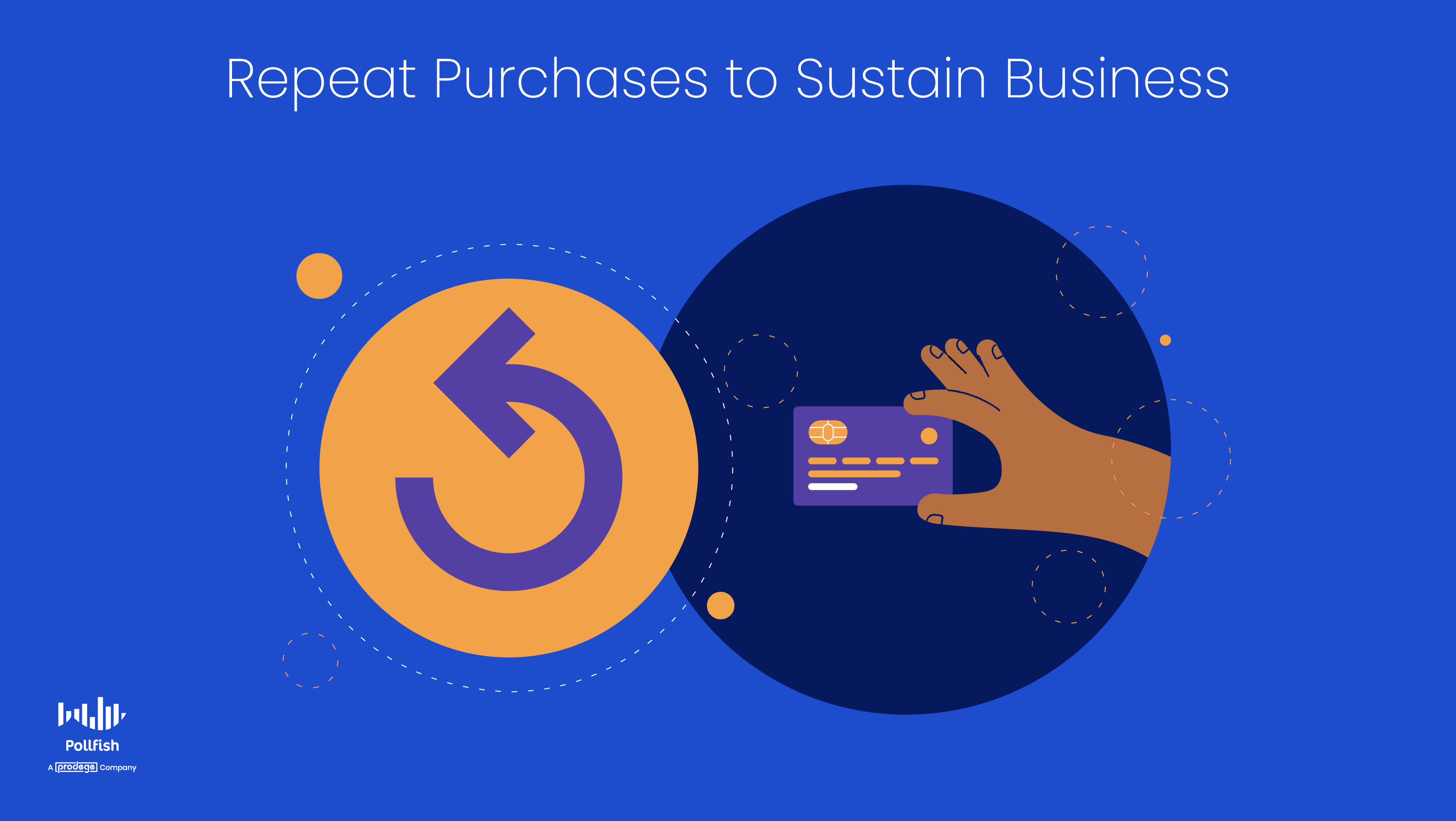
You’ll need to cultivate repeat purchases from your customers given the weight of customer retention. Even if you operate a B2C retail establishment, your business will greatly benefit from existing customers shopping from your business continuously.
90% of customers are more likely to purchase more, and 93% of customers are more likely to make repeat purchases at companies with excellent customer service.
61% of SMBs report that more than half of their revenue comes from repeat purchases of existing customers, rather than from new customers. These statistics demonstrate how clear the value of repeat purchases is.
However, despite these perceptible benefits, 96% of customers stop doing business with a company due to poor customer service. This damaging statistic proves that almost all customers will not simply make fewer purchases with a business, but abandon it entirely.
As such, brands must elevate their CX and understand their customers to retain customers.
This article explores the concept of repeat purchases, their implications, importance and how to foster it with survey research.
Understanding Repeat Purchases
A self-evident concept, repeat purchases refer to instances of customers purchasing more than once from the same business. This behavior is usually associated with buying from a business multiple times, instead of just twice.
As such, repeat purchases result from customer retention, which is the result of consumer loyalty. There are many building blocks of loyalty, including providing a great customer experience, reasonable prices, product satisfaction, brand equity, brand trust, satisfying all of your consumer preferences and more.
When strategizing how to stimulate repeat purchases, businesses can create various campaigns, from advertising to PR, social media and various others to facilitate repeat purchases through different purchasing methods. This means that although you may have customers who purchase in-store, you can still pique online or phone orders.
For example, assume you have a customer persona who prefers buying via the brick-and-mortar way. They can still be swayed to make an online purchase, should it be compelling enough. You can achieve this by offering a special online promotion, introducing an online rewards program, or appealing to this persona in some other way that makes it tempting for them to buy online.
At any rate, you can forge repeat purchases through omnichannel communications and various purchasing options.
The Importance of Repeat Purchases
Repeat purchases are important for several reasons.
First off, when customers buy from the same company, it is a sign of customer loyalty, which means that not only will your customers continue buying from you, but they will be less inclined to shop from your competitors.
As such, you’ll be drawing in a larger customer retention rate, and as you’ve read across multiple CX, marketing and eCommerce outlets, customer retention is more profitable than acquisition. Various figures prove this, such as the fact that acquiring new customers costs five times as much as keeping existing ones and that selling to existing customers has a success rate of 60-70%, while it is only 5-20% for new customers.
High levels of repeat purchases also point to a low customer churn rate, another necessity for keeping your business afloat, given the need to retain a stream of customers. In addition, once customers churn, it is going to be difficult to bring them back to your business, as they've already made up their minds — and not from hearsay but their experience from being your customers.
If your customers didn’t like your products, they wouldn’t buy them — unless it was due to utter necessity and no other choice. As such, when customers buy repeatedly from you, not only are you lowering your customer acquisition cost due to higher retention, but you’re also building trust around your brand. The more customers buy from you, the more reliable you are perceived to be.
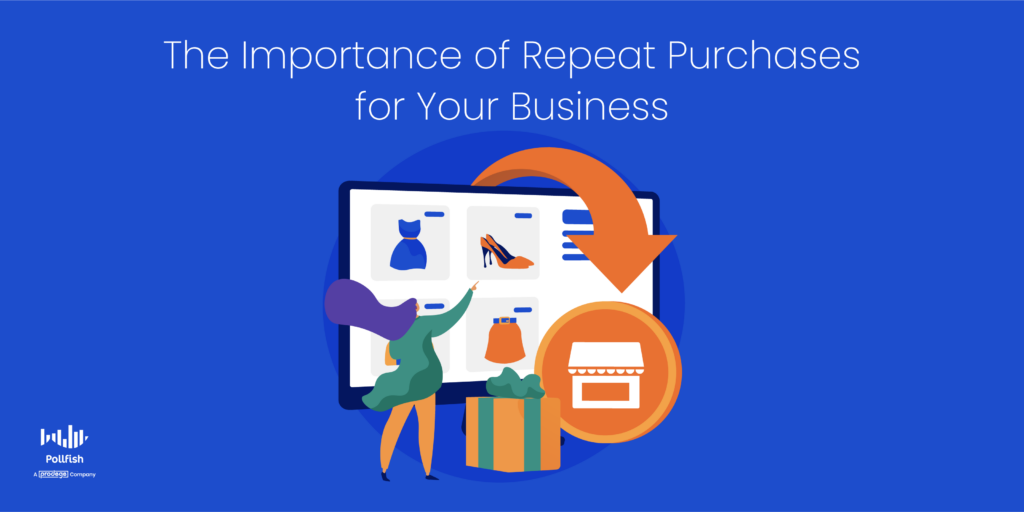
Customers who make repeat purchases are also important given their higher expenditures, as repeat customers spend 67% more than new customers. This isn’t surprising, as retained customers know what to expect from their favorite brand(s), therefore being more liberal with their spending.
Customers who buy from you year after year are critical, as they signify a segment that has the potential or currently carries a high Customer Lifetime Value. This metric relays the worth of customers during their entire relationship with the company. It involves both purchases and the length of a relationship customers have with businesses.
Value also increases in reverse, meaning that a brand appears to be more valuable to customers who make continuous purchases. As such, these purchases exemplify high levels of customer value, which is the perception of what a product or service is worth to a customer versus its alternatives.
All in all, when customers make repeat purchases, they are easier to sell to, improve a brand’s reputation and generate higher overall value for a company.
7 Effective Ways to Increase Repeat Purchases
Businesses can try experimenting with different methods to increase and strengthen customers by making repeat purchases.
The following enumerates 7 methods you can use to increase repeat purchases:
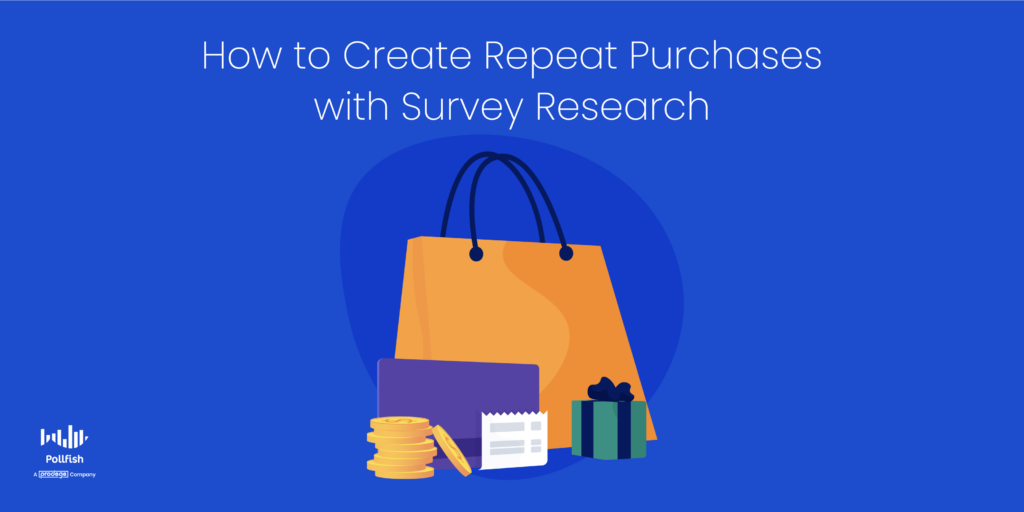
- Offer perks via VIP programs.
- These programs grant elite status to customers who buy more, directly leading to repeat purchases.
- Create referral programs with incentives for current customers that bring in new ones.
- This will whet customers’ interest in staying customers, as they will be rewarded.
- Create discounts and seasonal campaigns to draw in continuous purchases for special occasions.
- This will entice customers to buy repeatedly by buying more than just one kind of product. For example, various Halloween candy or Christmas decor.
- Retarget customers via email marketing.
- Target your customers directly after they make their first purchase via email marketing.
- You can give them the option of subscribing to a mailing list or suggesting similar products now and then.
- Create exclusive deals for customers through rewards programs.
- While creating seasonal promotions is useful, you can extend your deals and discounts by creating rewards programs for customers.
- This directly leads to customers buying more.
- Appeal to customers with marketing personalization.
- No one likes to be marketed to, especially in generic ways.
- Creating personalization makes customers feel seen, heard and far more special than they would as recipients of non-personalized offers and messages.
- Ask for user-generated content.
- This involves content that your consumers produce via using your products and services, which you then feature across your website and other digital properties.
- This method creates bonds between brands and customers, which gives brands an edge in that customers view them as more than just another business.
How to Stimulate Repeat Purchases with Survey Research
Market research is the underlying mechanism for increasing repeat purchases. This is because, to appeal to your customers, you’ll need to understand them at a deeper level. This way, you can properly market to and serve them.
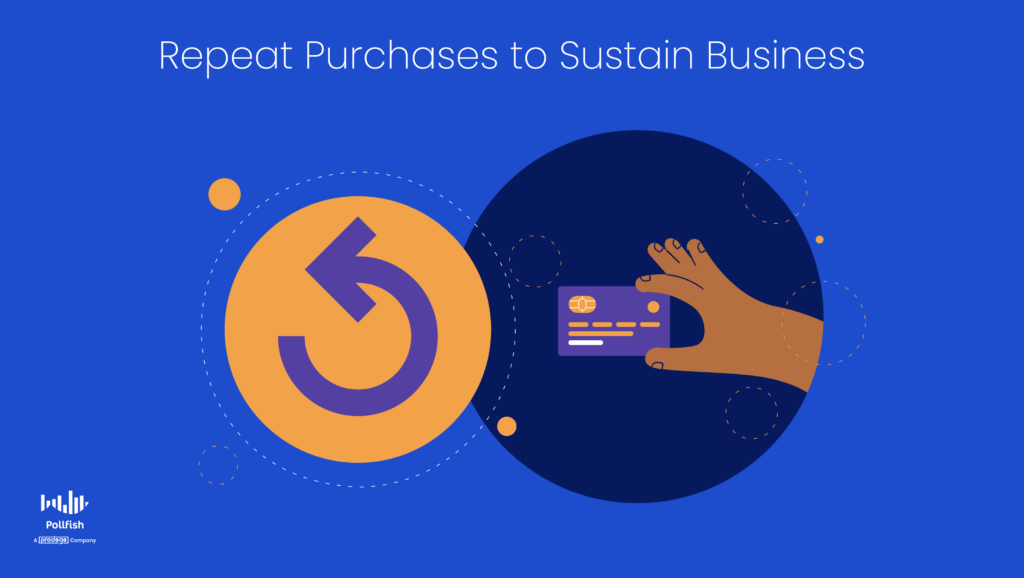
When you understand all of your customers’ desires, needs, aversions and perceptions, you’ll be able to create marketing campaigns that compel them to interact with your brand, as you push them further down the sales funnel until they convert.
There are various market research techniques that you can apply to better understand your customers; this involves gaining insights into customer behavior and your customer’s needs, along with their reactions to your current marketing campaigns.
Wheel secondary market research is a good starting point for learning about your customers, your best bet is to gain insights that are timely and unique to your target. You can achieve this by conducting survey research, a kind of primary research.
Surveys allow you to inquire into any topic, granting you full control over your market research study. You can create surveys for several purposes, as there are various surveys and different types of survey questions you can ask.
The following lists some of the key survey types to use to increase repeat customer spending:
- The customer service survey
- Bad service can deter customers from making any further purchases from you and this survey gauges your customer service.
- The customer retention survey
- Given that repeat purchases indicate retention, use this survey to help you determine your degree of customer retention.
- The CES survey (Customer Effort Score Survey)
- This survey measures customer effort, the degree or amount of effort that a customer puts into a certain interaction with a company.
- The longitudinal survey
- You can measure the opinions your customers have on your products and services by surveying them over longer periods with this kind of survey.
- The product satisfaction survey
- Especially useful for observing attitudes and opinions of your products, this survey allows you to get direct feedback on the products themselves.
- This helps you improve your product features and innovate new ones.
Fueling Your Business
You should always aim to encourage your target market to make repeat purchases. After all, these are the lifeblood of customer retention, yielding all of its benefits. To spur this shopping phenomenon, you’ll need to understand your customers at a deeper level.
You’ll need a strong market research platform to host your survey campaigns. Such a platform should run on random device engagement (RDE) sampling, so that you can reach customers in their natural digital environments, instead of pre-recruiting them. This removes social pressures in the surveys and will cut back on survey bias.
You should also use a mobile-first platform, as mobile dominates the digital space and no one wants to take surveys in a mobile environment that’s not built for them.
The online survey platform you opt for should also offer artificial intelligence and machine learning to remove low-quality data, offer a broad range of survey and question types and disqualify low-quality data.
It should also allow you to survey anyone. As such, you’ll need a platform with a reach to millions of consumers, along with one that offers the Distribution Link feature.
This feature will allow you to send your survey to specific customers, instead of only deploying them across a vast network.
With an online survey platform with all of these capabilities, you’ll be able to motivate your customers to make repeat purchases.
The Best UX Survey Questions to Power Your Surveys
The Best UX Survey Questions to Power Your Surveys

You need to have a reliable set of UX survey questions to power your UX survey. The questions steer the direction of your entire study and campaign and should therefore be woven carefully.
This kind of survey assesses user behavior in relation to your products, services, digital experiences and other user experiences. It is meant to reveal how your consumers experience your offerings firsthand, revealing the difficulty and ease of using your products.
Achieving a good UX is critical for numerous reasons, such as the fact that top companies that lead in UX outperformed the S&P index by 35%. Good UX also has a strong ROI, as every $1 invested in UX, brings $100 in return, indicating an ROI of 9,900%.
You ought to avoid bad UX like the plague, as it even turns away the customers who love a brand. In fact, 32% of customers who love a brand will leave it after just one bad experience.
This article presents various examples of UX questions, their importance in different settings and where in the customer buying journey to use them, so that you are never at a loss of how to fill your UX survey.
The Importance of UX Survey Questions Throughout Different Touchpoints
There are various touchpoints that you should use as the basis of your UX survey questions, as the experiences your users undergo there are critical to study.
By asking questions based on different moments in the buying journey, which include pre and post-sales, you’ll paint an accurate picture of how your consumers perceive all of your UX offerings, whether they are digital or physical.

This includes understanding the difficulty and ease of interacting with your company and using your products, services and experiences. As such, you can use the insights from your UX survey questions to improve across all customer touchpoints, accelerate product innovation and ease the process of your experiences.
Additionally, by studying UX across various touchpoints, you’ll unearth your consumer preferences, see what’s driving demand in your offerings specifically, understand what’s inciting repeat purchases and much more. The key is to ask relevant and specific questions.
Where to Use and Draw Inspiration for UX Survey Questions
While it is important to look at your customer experience as a whole, there are several key moments that you should zero in on to study your UX.
These provide excellent opportunities for asking UX questions, whether they involve questioning users then and there, or following up with a UX survey that asks questions on different points in their UX.
The following lists key moments in the buying journey to pay attention to and use for UX survey questions:
- The first visit(s) to your website, mobile site, app or other digital property
- When: Pre-sales
- After an asset download
- When: Pre-sales
- This is especially useful for B2B consumers.
- Interactions with a UI element or experience
- When: Pre or post-sales
- This can involve quizzes, games, UI marketing collateral and more.
- Subscription sign-ups
- When: Pre (if free) or post-sales (if paid for)
- This can be a free or paid subscription to content.
- Trying a product via an in-home use test
- When: Pre-sales
- This involves the users trying out your products, who are usually recruited for market research purposes.
- For customer development
- When: Pre-sales
- This is a framework used to discover whether a product satisfies the need(s) of a target market, part of the lean startup concept in order to bring a product to market more efficiently.
- After a week or more of purchasing a product or digital asset.
- When: Post-sales
- This is especially necessary if you collected the customers’ email addresses.
- During present usage of service, product or app
- When: Post-sales
- Example: UX with an app, a subscription, a product, a feature, etc.
Examples of UX Survey Survey Questions to Use
Now that you understand the importance of using UX survey questions across different stages in the customer buying journey, along with the specific times to use them, let’s analyze the heart of the survey: the questions.
Aside from being able to come up with reliable UX questions, it is key to be able to organize and label them. This will help you think up and sort new questions as they arise.
The following provides examples of useful UX survey questions to use in your UX survey:
- Have you used the [new tool/feature]?
- Question type: Yes or no
- When to use: After (or during) the first visits to your website, mobile site, app or other digital property
- Follow up? If yes, go to Question 2
- How easy was it to use [new tool/feature] on a scale of 1 (very difficult) to 5 (very easy)?
- Question type: Likert scale
- When to use: As a follow-up to the previous question, during present usage of product, service or app
- Follow up? If the answer is between 3-5, follow-up with an open-ended question
- Was this [asset name] helpful?
- Question type: Yes or no
- When to use: After downloading an asset
- Follow up? Yes, with an open-ended question about how it was helpful.
- What are your first impressions of [UI element]?
- Question type: Multiple-choice, multiple selection and open-ended questions
- When to use: After interacting with a UI element
- Follow up? Yes, with an open-ended question to explain the reasoning
- Did you enjoy [UI element]?
- Question type: Yes or no, or multiple selection ranging from “not at all” to “very much.”
- When to use: After interacting with a UI element
- Follow up? Yes, with an open-ended question to explain this answer.
- How easy was it for you to sign up for this subscription?

- Question type: Likert scale
- When to use: After signing up for a content, SaaS or physical subscription
- Follow up? Yes, with an open-ended question on how to make it easier/better.
- Did this product have any glitches or things you would change?
- Question type: Multiple-choice of “none at all”, “1-3 things, but they aren’t major,” “1-3 things and they’re important,” etc
- When to use: As part of an in-home use test
- Follow up? Yes, with an open-ended question on what the problems the customer incurred or features they would like to see improved.
- What is one thing you would change about [tool/feature]?
- Question type: Multiple-choice, multiple-selection
- When to use: As part of customer development/ product innovation
- Follow up? Yes, with an open-ended question to explain further.
- What are the best / worst parts about using this [product, service, digital experience]?
- Question type: Multiple-choice, multiple-selection
- When to use: After a customer has used a product for a certain amount of time
- Follow up? Yes, with an open-ended question to explain what they like and dislike about their UX.
- Did this [UX/UI element] help you? Was it easy to use?
- Question type: Yes or no or Multiple-choice of “not at all” to “yes, completely.”
- When to use: Interactions with a UI element
- Follow up? Yes, with a multiple-choice question on the easiest and most helpful aspects or those that aren’t.
Excelling in UX
Improving your UX and keeping customers satisfied in this regard goes a long way towards providing customer satisfaction and building consumer loyalty. You should therefore strive to optimize your UX whenever possible.
To do so, you’ll need a strong online survey platform, one that offers advanced skip logic to route respondents to relevant follow-up questions based on their previous answers. It should also make it easy to form a customer journey survey to survey your respondents across their customer journeys.
The best-in-class platform uses random device engagement (RDE) sampling, for reaching customers in their natural digital environments, instead of pre-recruiting them. This removes social pressures in the surveys and will cut back on survey bias.
You should also use a mobile-first platform since mobile dominates the digital space and no one wants to take surveys in a mobile environment that’s not built for mobile devices.
Your online survey platform should also offer artificial intelligence and machine learning to remove low-quality data, disqualify low-quality data and offer a broad range of survey and question types.
Additionally, it should also allow you to survey anyone. As such, you’ll need a platform with a reach to millions of consumers, along with one that offers the Distribution Link feature. This feature will allow you to send your survey to specific customers, instead of only deploying them across a vast network.
With an online survey platform with all of these capabilities, you’ll be able to collect data on cultural awareness and virtually any topic.











 Avoid receiving gibberish answers thanks to the Pollfish AI-powered survey platform
Avoid receiving gibberish answers thanks to the Pollfish AI-powered survey platform




